Road Trips
This document is a repository of the need for on-site genealogical work in my family
tree. The intention is for the reader (myself or others) to use this information to
plan a trip to perform one or more such efforts. I've found that this information is
very challenging to organize. My attempt to solve this is to organize it geographically.
One of the great challenges in genealogy is to keep track of how counties changed,
which points to where to do research, as modern counties are often different than they
were back in the day. I've mostly not repeated the narratives of each line in the
surname pages, but I've tried to include the most burning questions that need on-site
research. If you want to organize a trip specific to a family line, use this document
and review the surname page which that line falls within to formulate a plan.
I attempted to integrate genealogical work in a vacation in 2019, and I learned that I
was woefully underprepared and it was almost completely futile. One, you have to know
how certain you are about an ancestor's residence. When you're not sure, you have to
be ready for a change of plans if you learn that you need to, for example, go to a
neighboring county to find records. You need to allot enough time to do the hard work.
You need to take clear notes of all information found, as well as whatever copies of
documents you can get. You can't just enter a library for an hour or two and expect to
find something. You have to make sure that facilities are open when you'll be there.
You really need to arrange to have someone there to help. County seats are usually the
place to go. Sometimes records are in courthouses, sometimes in libraries, sometimes in
historical societies. Search any site you visit beforehand to identify what resources
it has, including museums. Presumably a road trip would be arranged to form a geographic
loop, whether you want to focus on one family line or research many. Our ancestors
traveled steadily westward in America, so as you travel east you'll go back in time,
and vice-versa. When you know you have family history in a particular place, just
being there has significance, and you might even find family-specific content in
museums and monuments.
Oklahoma

Oklahoma became the 46th state in 1907. It became an American possession with the
Louisiana Purchase in 1803. Oklahoma became part of the Arkansas territory in 1819.
When Arkansas became a state in 1836, Oklahoma was split into the Oklahoma and Indian
territories. One Oklahoma line that I'll mention here is Howell, because I don't know
what county they were in. All I know is Dave Howell was born in Oklahoma in 1895 and
returned to his parents' home state of Mississippi by the outbreak of World War I. I
assume that Sam and Beulah took part in the Land Runs that began in 1889, and they
might've been in the 1910 Oklahoma census but they've fallen through the cracks in one
of the swaths of those documents that are unreadable.
McCurtain County
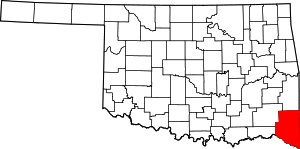
McCurtain was formalized in 1907 when Oklahoma became a state. The county seat is
Idabel. I put this information here because documents may be found in Idabell, but
our family history in the area was before 1837 when it was part of the Arkansas
territory. This was the original Miller county of Arkansas, formed in 1820.
Lines in Miller: McAtee 1815-1834
William McAtee was documented on the Texas side of the Red River in 1828, but
resided in the Pecan Point settlement previously. Pecan Point had been established
on the American side of the River, as the other side was Mexico at the time. Still,
the Choctaw Nation was soon formed where Pecan Point lay, and the settlers were driven
out. One of these settlers was Claiborne Wright, whose second wife was Harriet Brown.
When Claiborne died, William McAtee wed Harriet and she was the mother of George B
McAtee. The former site of Pecan Point is around an oxbow lake today, called
Forty-one Cut-off Lake, south of Idabel on highway 259. There may not be much more to
see than a sign recognizing the settlement now. Idabel has a Red River Museum that no
doubt would be interesting to visit.
McClain County

McClain was formed in 1907 from Pontotoc. The county seat is Purcell. McClain was
part of the Unassigned Lands that were the subject of the Land Runs beginning in
1889. Purcell might be worth visiting in researching the Howell line, for any info
that can be found about the Land Rush period. They have a historical and genealogical
society and museum.
Lines in McClain: Hollis 1910-1945, Hardcastle 1917-1945
Taylor Hollis came to McClain when he was 20, most likely as part of a wagon train of
other families. He was very much an eligible batchelor when the Hardcastles arrived,
and he wed Elva. Taylor had been born in Alabama. The Hardcastles came from Arkansas,
but they were also relatively late migrants across the Mississippi for our family
tree.

Bryan was formed 1907 in Choctaw territory. The county seat is Durant. None of our ancestors lived there, but George B McAtee and his brother William helped to build Fort McCulloch there during the Civil War. It was on the Blue River near modern Kenefic. I'm not aware that anything is there today. The fort was manned by an "Indian" garrison under Albert Pike. To the north of Bryan is the town of Atoka, where comrades of the McAtees who died of disease on the trek to the fort were probably buried in the Civil War cemetery. Bi Hardcastle was also buried in Atoka. Draper relatives failed in attempts to enroll in the Choctaw Nation, where they probably would've been successful if they had documentation. I think a few generations back, our Drapers were definitely more than 1/128 Missouria, which in our case ended up merged with the Choctaw. The Choctaw capitol museum is in Tvshka Homma, which is southeast of McAlester off highway 271.
Grady County
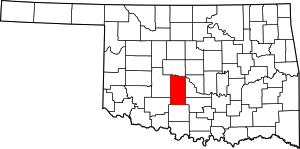
Grady was formed 1907 in Chickasaw territory. The county seat is Chickasha. One mystery in the McAtee line is William R's household was in Tuttle in the 1930 census. By 1940 they returned to Vine Prairie Arkansas. But my grandfather was actually in a fort in Laramie Wyoming in 1940. I'm not sure if he first returned to Arkansas. My grandfather fought in World War II, but 1940 is fairly early, before Pearl Harbor, and suggests that he joined the military without necessarily expecting to be in the War.
Texas

Texas became the 28th state in 1845. Two areas of American settlement began decades
before, one in the familiar Austin colony in Mexican territory, but another on the Red
River. The Republic of Texas was formed in 1836, which lasted until Texas became a
state. We have no known family history in Nacogdoches, but the East Texas historical
society would be worth visiting there. George Leonard was a very early settler of
Dallas, and owned large amount of land that must be insanely valuable today. See the
Leonard part of the Scott document for more info, if you want to make a visit.
Red River County
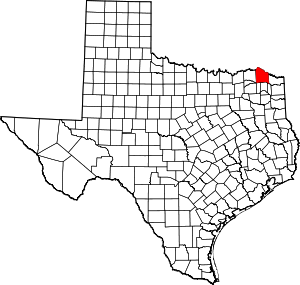
Red River was formed in 1837. The county seat is Clarksville. I put this information here
because documents may be found in Clarksville, but our family history in the area was
before 1837 when the area was part of the Arkansas territory. This was the original
Miller county of Arkansas, formed in 1820.
Lines in Miller: McAtee 1815-1834
William McAtee was recorded in the 1828 census of the Pecan Point settlement, on the
Red River. He was also listed in the 1830 attempted formation of Wavell's colony. I
expect that he actually frequented the Red River from as early as 1815. At one point
residents of Pecan Point moved from what is now Oklahoma
on the north side of the River to the south side. This was knowingly entering Mexican
territory at the time with the intent of joining Mexico, because the United States had
allocated the north side to the Choctaw tribe and drove the settlers out. As we know,
the Texas Revolution would change things, but William moved out of future Texas in 1834.
Clarksville was named by Benjamin Clark Jr, who was our ancestor Elizabeth Clark's
brother.
Titus County
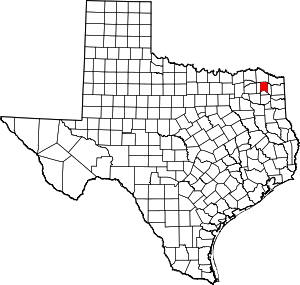
Titus was formed in 1846. The county seat is Mount Pleasant. At least part of Titus
was for a time tentatively part of Old Miller County of the Arkansas territory. I say
tentatively, because after the Louisiana Purchase, the United States claimed that the
southern boundary of that territory in future Texas was somewhere to the south of the
Red River. Mexico claimed that the Red River itself was the boundary, and eventually
the US agreed to it. Before then, the southern border of the Arkansas territory was
projected westward beyond the eventual borders of the state, through what would become
Titus county Texas. Titus was definitely part of the American settlements that formed
on the Red River before the Texas Revolution.
Lines in Titus: Hollis 1898-1910
Eli Hollis moved the line to Titus from Alabama when Taylor was eight years old.
Evidently prospects weren't good there, as Taylor moved to Oklahoma when he was 20.
I've camped in that area. It's got lots more trees than the rest of the state, and
there isn't a mountain in sight. The Hollis residence was in justice precinct 1 on
Daingerfield Road. There doesn't seem to be a Daingerfield road anymore, so I'd guess
it's what's called Ferguson road today.
Arkansas

Arkansas became the 25th state in 1836. It became an American possession with the
Louisiana Purchase in 1803. In 1812 it was incorporated into the Missouri territory.
When Missouri became a state, Arkansas was part of the Arkansas territory from 1819 to
1836. The land west of the final boundary of the state became part of the Indian
territory and a few counties in the northeast corner of Texas, forming the notch in the
southwest corner of Arkansas. We don't have deep residential history in northwest
Arkansas, but I'll note here that the McAtees (and probably Duncan Meredith) fought at
Pea Ridge in the Civil War, and a visit to the National Park northeast of Rogers would
be worthwhile. George B McAtee's brother Royston was killed in the battle. Our
Newcombs lived in Lawrence county from which Thomas was part of Bean's Rangers in
Oklahoma.
Hempstead County
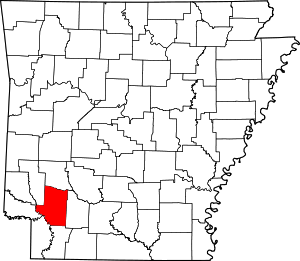
Hempstead was formed in 1818 while Arkansas was part of the Missouri territory. The
county seat is Hope.
Lines in Hempstead: McAtee 1834-1845
William McAtee brought our line to Hempstead from the Red River, in what was also the
Arkansas territory at that time. George B was about two years old. His birth was placed
in Texas in later censuses, and though the area of the Pecan Point settlement was in Texas
at the time of those censuses, technically that was incorrect. Their address in 1840 was
Maine Creek, which was northwest of Washington Arkansas. Maine Creek is not on the map
today. The Red River comes close to Washington, and I believe that William was active on
it from as early as 1815, so I expect that he was familiar with Hempstead county long
before he moved there. Washington was effectively the capital of the state before power
shifted formally to Little Rock, and Washington was a key waypoint for Revolutionaries
headed to Texas. Stephen F Austin practiced law in Hempstead before starting his colony
in Texas. William McAtee moved to Hempstead to take advantage of a law created where
settlers who made improvements on land in the future state by 1833 received a grant for a
certain acreage including the improved area. Hempstead county was important to the early
history of Arkansas, and it was a gathering place for many of the lines in the McAtee
tree, especially Hunter. Clark, and Brown. Many lines in the McAtee tree settled
Arkansas before it was a state, and they came to the Red River area in the southwest
corner. Hardy Hunter may have been on Beard Lake as early as 1812. Research in Hempstead
should begin in Hope and Washington. I'm not sure if any records are kept in Washington.
Crawford County
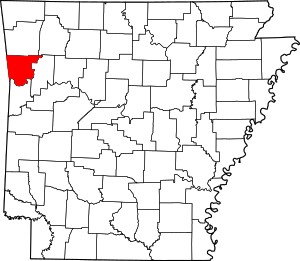
Crawford was formed in 1820 from Lovely county and formerly Indian lands. The county seat
is Van Buren. The genealogical society is in Alma.
Lines in Crawford: McAtee 1880-1929, Griffin 1888-1929, Tapp 1875-1885, Parrish 1888-1943
Crawford was a very significant county in the McAtee tree. I knew this before I got into
genealogy, because I knew my grandfather came from there and we went to family reunions
there. I also knew that my grandfather suggested Fort Smith as a place to live for my
parents. Naturally, my grandfather's ancestors came together in Crawford. I grew up
familiar with Van Buren and Alma, and we played golf in Dyer. What I didn't know was the
patriarch was my grandfather's grandfather George C McAtee. George was in the 1880 census as
a 17-year old farm laborer in the area of Alma. He married into our Tapp line there. In
1900 he lived in district 47, and in August of that year his mother died in Rudy. His son
William R wed 1909 in Mulberry and listed his residence there in 1917 when he registered
for World War I. He described his hair as "read". He moved to Vine Prairie by 1910 where
the McAtees had a Little House on the Prairie, as it were. William lived on Rail Road
there in 1920. I visited the house in Vine Prairie as a child, but Rail Road doesn't seem
to exist anymore. I do know that a rail line was established in the area in the 1870s.
William listed his address as Route 3 Mulberry in 1942. Our kin are buried in two
cemeteries in Mulberry. My mother's parents are buried at New Mulberry Cemetery on Alma
Avenue. After George C raised his family, he moved to Fort Smith. In 1910 he lived at 613
South 18th Street and was a factory foreman. In 1920 he lived at 1115 North 7th Street and
worked at a furniture factory. In 1930 the house number was the same but the street was
listed as 6th. He was a factory worker, not specified as furniture. The 1930 city directory
clarifies that he was a labor inspector at the Tucker Duck and Rubber Company on Towson. His
address was put as 1115 North 7th Street on Mattie's death certificate.
He was buried in Oak Cemetery on Greenwood Road.
Pike County

Pike was formed in 1833 from Hempstead. The county seat is Murfreesboro. Courthouse fires
in 1855 and 1895 destroyed much of the county records.
Lines in Pike: Hardcastle 1891-1917, Draper 1890-1917
Thomas Hardcastle raised his family in Pike for around 30 years before moving on to Oklahoma.
The Crater of Diamonds State Park is nearby. Joseph Hardcastle is buried at Shiloh cemetery
which is 5 miles east of Newhope. They were in the township of White in 1900. White doesn't
seem to exist anymore, so presumably the cemetery used to be within it. The Drapers are
associated with the placename Star of the West. There's been some confusion over whether
the Hardcastles were in Texas, mostly because my great grandmother Elva was born in 1897 and
she claimed in her marriage document that it was in Texas. Pike County isn't far from
Texarkana, so maybe they moved around a bit. But most likely it was a mistake, or there was
some reason to falsely claim it.
Franklin County
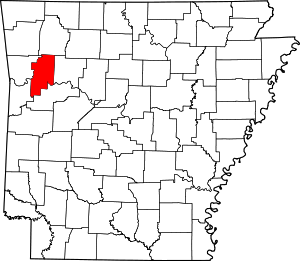
Franklin was formed in 1837 from Crawford. The county seats are Charleston and Ozark.
Lines in Franklin: Parrish 1870-1888
Our Parrish line lived in the Prairie township, which is near Clarksville. In 1870 their
post office was Ozark. We used to take highway 22 through Clarksville often to visit my
mother's parents in Morrison Bluff before a bridge was built across the Arkansas River from
I-40 that we could then take. I never wondered if they might've lived around there based
on family history.
Desha County

Desha was formed in 1838 from Arkansas county. The county seat is Arkansas City. Though
the McAtees never lived in Desha, Fort Hindman was there and the battle of Arkansas Post
there during the Civil War was one of the most significant events in our family tree.
There's a museum near to the National Park there. When I began research of the Scotts,
Frank's birthplace was claimed in Desha. This never made sense to me, and is disproven
by a newspaper article which makes clear that Montgomery County was always the clan's
destination. They crossed the Mississippi River at Memphis and traveled to Montgomery
overland.
Lines in Desha: Parrish 1867-1870
The Parrishes entered the state in Desha. John was the postmaster of Pendleton while they
were there. Pendleton was a promising settlement at the time, but eventually faded when a
railway was built that bypassed it. I suppose the Parrishes must've arrived via boat on
the Mississippi River, because they came from the southeastern hook of Missouri on the River.
Their life around the time of the Civil War bore some similarity to Mark Twain's, though
I'm not aware of any Parrishes working on steam boats. Samuel Clemens had yet to adopt
the name at that time, and it was years later when he became famous.
Montgomery County
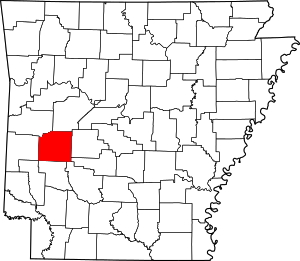
Montgomery was formed in 1842 from Clark. The county seat is Mount Ida. Mount Ida also
has a Heritage museum.
Lines in Montgomery: Scott 1851-1920, Meredith 1850-1920, Burrell 1870-1920, also
Whisenhunt, Leonard, Newcomb, Markham, Nance
Montgomery county is to the Scotts what Hempstead and Crawford together are to the McAtees.
Our Scotts and relatives didn't arrive as early as the McAtees, having roots in the previous
decades in Tennessee and Georgia. They came directly to Montgomery and remained there to
some extent even today. About four miles south of Mt Ida on highway 27 is Owley Road, going
to the east. Around 2000 feet down the road to the right is a wooded area beyond a gate.
Within the woods is Scott Cemetery, where Frank and his relatives are buried. Most of the
graves are marked with pieces of slate, and presumably one of them is Frank's father
William's. The site of their home has either been replaced by current buildings, or
possibly the remains of it could be found within the woods. This is private property, which
I got access to by contacting Barbara Eubank via her ancestry.com account, and I think it
was her uncle who showed us around. He mows the cemetery grounds, and if no one takes over
for him to do that, it will be comsumed by the trees. Farther down Owley road is a church
building that I think is about a hundred years old, and the Owley Cemetery. In that
cemetery Doshie Anderson, Grover Scott's first wife is buried. So is
Lon Warneke, called the Arkansas Hummingbird, former major league pitcher for the Cubs and
Cardinals and Arkansas judge, and grandson of Frank Scott. One mystery to solve is the
1870 census, where Duncan Meredith and William T Scott's families haven't been found anywhere.
Duncan's father John was in Montgomery, as was Mary E's father William, and Frank Scott's
elder brother William A. But where were the others? Did it have something to do with the
Civil War?
In 1884, Frank Scott was granted 80 acres in South Fork, like that of John Meredith in 1882.
These were a consequence of the 1862 Homestead Act signed into law by Abraham Lincoln. The
families had already been in the area for a decade before the Act was initiated, and the
requirement for it was to claim the land and build a dwelling and cultivate it. The
standard was 160 acres, so I'm not sure why Frank ended up with half. Maybe a brother of his
claimed the other half. William Thomas Meredith lived on 45th Street in Gap in 1880, and in
district 132 of Gap in 1900. In 1900 Frank's address was James Street in South Fork.
There's a Scott Drive in northwest Mt Ida, but I don't know what the source of the name is.
In 1920 Grover lived on Old Manaford Road in Womble, after wedding Sallie Meredith in 1919.
Frank had moved to Womble as well, at Palkowski and Warble Street. Womble is now called
Norman, south of Mt Ida on highway 27. The Crystal Springs campsite is in Norman, and I've
used it. In 1930 Grover Scott lived at Palestine and Ringville Road. My grandfather
returned to the area from Mississippi, in Hot Springs County. The address that I'm familiar
with is 109 Banks Street in Hot Springs. Their address in 1957 and 1960 was 17 Drexel.
Grover and Sallie got a divorce and in 1953 her address was 419 Quapaw Avenue. The city
directory said she was his widow, which is interesting because he lived until 1961. It may
be that my grandfather moved to Hot Springs because she moved there.
Howard County
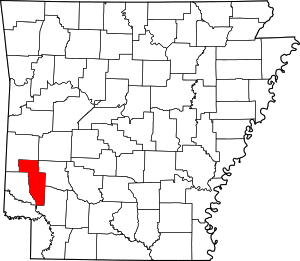
The McAtees came to Polk county in 1845, living in the Sulphur Spring township. Polk was
formed in 1844 from Hot Spring county. The county seat today is Mena. I put this entry
under Howard county, because I'm not aware of any ancestors living in modern Polk. Howard
was formed in 1873 from Polk. The county seat is Nashville, but had originally been in
Centre Point. I expect that any records from Sulphur Spring would be in Howard today.
Nashville has a historical society.
Lines in Polk/Howard: McAtee 1845-1880
William McAtee's real estate value in the 1850 census was $10,000. That is equivalent to
$1,000,000 today. When hired genealogists pointed this out back in the day, it prompted the
question of where that wealth went. Well, we know now that it was based in his and Harriet's
23 slaves, and their family was devastated by the Civil War. Our link back to them is George
C McAtee, who came to Crawford county in 1880 as a farm laborer with no wealth at all. We
today don't have to face the dilemma of having wealth that was built on the back of slaves.
George B McAtee was listed in 1850 as a mail carrier. In 1860 he headed his own household
and his residence was near the Shetucket post office. He owned half of the family wealth
from 1850. His mother Harriet lived with his brother William and they owned the other half.
Sulphur Spring no longer exists, but its coordinates were directly north of today's Blue
Spring campground on Lake Dierks. The closest town nowadays is Umpire, and I believe that
Hunter kin lived there.
Grant County

The Drapers came to Saline county by 1860, living in the Merry Green township. Saline was
formed in 1835. The county seat today is Benton. I put this entry under Grant county,
because it was formed from Saline in 1869 and the Drapers resided in the Grant part of the
former Saline. The county seat of Grant is Sheridan. I expect that Merry Green records
would be there.
Lines in Saline/Grant: Draper 1860-1890
The post office of the Drapers in Merry Green was Cherry Grove. William Draper began to
raise his own family in Darysaw township, with post office at Sandy Springs. He was in
Washington Town by 1880, not to be confused with Washington in Hempstead county. The
Hunters and Hudgens were also in Saline before Grant was formed.
Missouri

Missouri became the 24th state in 1821. It became an American possession with the
Louisiana Purchase in 1803. In 1812 the Missouri territory was formed.
Mississippi County

Mississippi county was formed in 1845 from Scott county. The county seat is Charleston.
Lines in Mississippi county: Parrish 1862-1867
Multiple of our ancestors may have set foot in the state of Missouri, but the Parrishes
are the only line that I know of who lived there for a time. Curiously, it appears that
they went there with the purpose of avoiding the south during the Civil War, as they came
from Tennessee and then went to Arkansas after the War was over. I wouldn't have assumed
this if it wasn't for John Parrish's wife claiming to have been born in Missouri in the
Arkansas censuses after the War. She was also from Tennessee. The only reason I can
think that she claimed birth in Missouri was to provide John an excuse for going to
Missouri during the War.
Alabama

Alabama became the 22nd state in 1819. Hernando DeSoto passed through what would become
the state of Alabama in 1540. France claimed it from 1702 to 1763. It became a British
possession from 1763 to 1783. Spain controlled it from 1783 to 1813, when it finally
became an American possession and part of the Mississippi territory. Coleman Draper wed
1821 in Jefferson county. KD Howell and his mother probably lived in Alabama in 1850,
but more research is needed to find a lead on exactly where. If Tennessee research of
Andrew Scott discovers that he was killed in service in the Creek War, that occurred in
what would become Alabama and should then be researched on site.
Lauderdale County
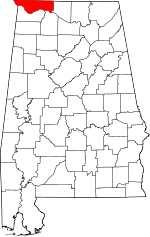
Lauderdale was formed in 1818. The county seat is Florence.
Lines in Lauderdale: Hollis 1881-1898
Taylor Hollis was born 1890 in Anderson. His father Eli led the line to Texas in 1898.
Jackson County

Jackson was formed in 1819 from Cherokee territory. The county seat is Scottsboro.
Lines in Jackson: Griffin 1865-1888, and Evans, Haney, Terry, Pace
The Griffins were in Jackson for a relatively short time, but it was an important
residence for them and relatives. John Griffin in our line was a comparably late-comer
as relatives lived there for decades before. This would be a good place to visit to
firm up information in the Griffin line. John's residence in Jackson was Berry's Stone,
post office Big Coon.
Fayette County
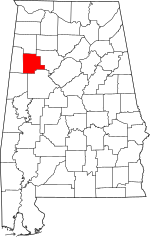
Fayette was formed in 1824. The county seat is Fayette.
Lines in Fayette: Carlile 1860-1890
George W Carlile Jr's residence in 1860 was in the eastern division.
Randolph County
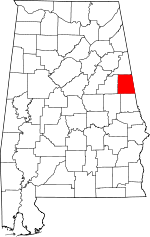
Randolph was formed in 1832 from Creek territory. The county seat is Wedowee.
Lines in Randolph: Hollis 1871-1881 and Medders
Elias Hollis lived at Roanoke, Fox Creek, Halpin, and Wedowee. The Medders lived at
Rockdale in 1860, and beat 15 in 1850. There may be some confusion in this info with
Clay and Lauderdale counties in the western side of the state, where these lines moved to.
Calhoun County
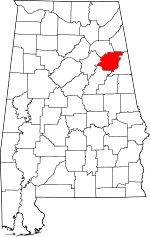
Calhoun was formed in 1832. The county seat is Anniston.
Lines in Fayette: Burrell 1860-1870
Paschal Burrell resided in Mount Polk north of Wellington. He registered to vote 1867
in Baine-Etowah.
Illinois

Illinois became the 21st state in 1818. The Illinois territory had been formed in 1809.
In 1820 the Markham line resided somewhere in the southern tip of the state, on their
way from Kentucky to Arkansas. In February 1863 George B McAtee, William, and
their cousin Thomas McAtee were delivered by train to Camp Douglas as confederate
prisoners of war. All three died there of disease. It's not clear where any of their
remains are, but presumably William's were transferred to the Oak Woods Cemetery in
Chicago because his name is on the Confederate Mound memorial. George B's name should
be on it as well, and its omission is another monument to how the prisoners were treated
at Camp Douglas. He negligently was lost track of. There is no sign of it now, and no
on-site memorial that I know of, but the camp was about five miles to the north of Oak
Woods, in the Douglas residential area around 31st street. Chicago museums that cover
the 1860s era would provide a context for the state of the city at that time,
particularly the Chicago History Museum.
Mississippi

Mississippi became the 20th state in 1817. The territory that would become the state of
Mississippi was controlled by France until 1763, when it became a British possession. In
1783 it was ceded to America, and in 1798 the Mississippi territory was formed. William
McAtee likely often visited Natchez. He probably was aware of a McAtee line
that was established there around 1812 when he came to southern Louisiana.
Panola County
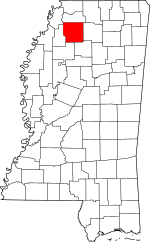
Panola was formed in 1832 from Chickasaw territory. The county seats are Sardis and Batesville.
Lines in Panola: Howell 1855-1873, Ellis 1841-1873
Panola was the arrival point of the Howell line and relatives. The northwest Mississippi
area was foundational to this part of the Scott tree. The Howell residence in 1860 was
Peach Creek. KD Howell registered to fight in the Civil War from Senatobia. The Ellises
lived in Batesville.
DeSoto County

DeSoto was formed in 1836 from Chickasaw territory. The county seat is Hernando.
Lines in DeSoto: Morris 1865-1873
The Morrises arrived in northwest Mississippi in 1865. John Morris was a farm laborer
in DeSoto 1870. The Howells came to DeSoto by 1870 and lived in township 5, range 9,
post office Arkabutta. Nancy Ellis was buried in Harmony cemetery in Strayhorn.
LaFayette County
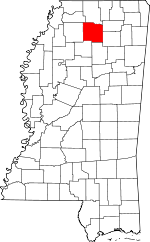
LaFayette was formed in 1836 from Chickasaw territory. The county seat is Oxford, home of
the University of Mississippi.
Lines in LaFayette: Youngblood 1860-1890
Beulah Youngblood wed into the Howells of northwest Mississippi, but her father Cadda
first resided in the state in LaFayette. He wed before that in Yalabusha county 1859. His
residence in LaFayette was Paris and he was a lumberman in 1870.
Pontotoc County

Pontotoc was formed in 1836 from Chickasaw territory. The county seat is Pontotoc. The
word is Chickasaw for "land of hanging grapes".
Lines in Pontotoc: Draper 1838-1870
Tate County

Tate was formed in 1873 from DeSoto. The county seat is Senatobia.
Lines in Tate: Howell 1873-1890, Carlile 1890-1900
The Howells lived on Savage road in 1920, after Dave returned to the line's ancestral
home after having been born in Oklahoma. His father Sam seems to have died in Oklahoma.
The Howells were back in DeSoto county in the 1940 census, I'm not sure exactly where.
John Morris wed Ada Carlile 1918 in Tate. He was buried in Strayhorn cemetery like
Nancy Ellis. My Scott grandfather moved to Byhalia by 1942, when he registered there
for World War II. The connection of the Howell line to my Scott line was enabled by
Grover Scott's move to Lee county Arkansas, which is across the River from northwest
Mississippi. They lived in Olive Branch when my father was born. Dave Howell died
in Oakville Tennessee in 1954 and was buried in Capleville. His wife Turley Morris was
also buried there, having lived five days past her 100th birthday. Dave's mother Beulah
lived at 1330 South Lauderdale in Memphis 1927. Ada Carlile lived at 420 Cambridge in
Memphis 1928.
Louisiana

Louisiana became the 18th state in 1812. It became an American possession with the
Louisiana Purchase in 1803.
Rapides Parish
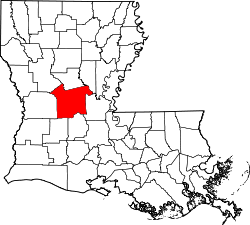
Rapides was formed in 1807. American merchants had been active in Alexandria actually
before the Louisiana Purchase, because the Mississippi River was key to trade in what
was the western extent of the country at that time.
Lines in Rapides: McAtee 1812-1828
The only fact of William McAtee's presence in Louisiana is that he registered for the
Battle of New Orleans from Alexandria in 1814. The battle occurred in 1815. Nothing else
certain is known about William from his father's move from Maryland to Ohio in 1811 to
William's documented presence at Pecan Point on the Red River in 1828. Alexandria is
also on the Red River, and given the McAtee family history of boating since they came
to America, I believe that William's primary activity from 1812 to 1828 was commerce
on the Red River. The primary settlements on the Red River in 1812 outside of
Louisiana were in Arkansas. I believe it was William's familiarity with Arkansas via
the Red River that led him to move there by 1834. His wife had also come from there.
William might have been active on the Mississippi River as well, and might have been a
'Kaintuck', someone who built a flatboat on the Ohio River and floated goods down to New
Orleans and Natchez Mississippi, then hiked or rode back to the Ohio River. His
father had settled on the Ohio River, on the Ohio side. The Louisiana History museum
would be worth visiting in Alexandria. Natchitoches is also on the Red River and was an
important port in William's time. Shreveport might have information. New Orleans of
course has information on the Battle of New Orleans and Andrew Jackson.
Ohio

Ohio became the 17th state in 1803. It was part of the Northwest Territory from 1787.
Scioto County
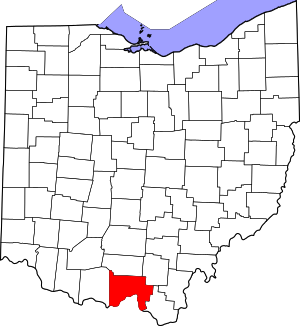
Scioto was formed in 1804 from Adams. The county seat is Portsmouth.
Lines in Scioto: McAtee 1811
Thomas II McAtee moved the line to the Nile township about 1811. William left by
1814 at the latest, but I suspect it was earlier. He was already 19 years old in 1811.
McAtee Landing is still a marker on maps there. William certainly departed for
Louisiana from there, and he may have repeatedly made the trip. Marietta Ohio isn't
in Scioto county, but it has an Ohio River museum that would be worth visiting.
Tennessee

Tennessee became the 16th state in 1796. It was formally part of North Carolina
from 1771. Technically it was claimed as part of the Province of Carolina from 1663.
The Long Island on the Holston river, site of modern Kingstown, is significant in
the Scott line. John Scott operated one end of a supply line in a fort there during
the period 1757-1763. The East Tennessee historical society in Knoxville would be
worth visiting. An interesting story in the Morris tree is that of James Brown who
was killed in what I believe became Maury county when attempting to settle there
when Nashiville was just a few years old, before Tennessee became a state. His
daughter Elizabeth was taken captive but survived, and later wed Isaac Morris. The
Smiths and Holsonbacks were in Coffee county.
Washington County

Washington district was formed in 1771 as part of North Carolina, initially occupying
the entirety of what would become the state of Tennessee. It was reformed as a county
in 1777. From 1784 to 1788, the populated eastern part of Washington attempted to be
part of the failed State of Franklin. In 1790 Washington county was reduced and the
future state of Tennessee was called the Southwest territory. Washington was further
reduced over the coming decades with increased population and the formation of other
counties. The Washington county seat is Jonesborough.
Lines in Washington: Scott 1795-1816, Sizemore 1775-1787, Leonard 1810-1816, Hartsell 1795-1816, and others
John Scott was in the Watauga/Holston area from 1757 during the French and Indian War,
but he never lived in Washington county as a head of household that I know of. His
son Andrew in our line moved to the Jonesborough area about 1795 when he wed Caty
Hartsell. I have the Hartsells arriving about the same time, but I don't know the
exact year. They came from farther east in North Carolina. I assume that Andrew met
Caty in Washington. Jonesborough is at the top of the list of places I want to make
a road trip to, because of Andrew's unknown end about the time he lived there. He
registered as a volunteer for the War of 1812, and by 1816 Caty was a widow. It
would seem that he died in the War, but I haven't found him in any casualty lists.
Hopefully Jonesborough holds more information about him. The Scott residence was in
Johnson City. The Hartsells were at the Brushy Fork of Cherokee creek. The Sizemores lived in what was
Washington county at the time, but later became Ashe county North Carolina.
Greene County

Greene was formed in 1783 from Washington. The county seat is Greeneville.
Lines in Greene: Carter 1783-1830, Trimm
Our Carters were a significant early family of eastern Tennessee. Their residence
in our line was Lick Creek. There's a historical marker today at Carter's Station.
Hawkins County

Hawkins was formed in 1787 from Washington. The county seat is Rogersville.
Lines in Hawkins: Sizemore 1787-1800, Ellis 1803-1841, Anderson
Hawkins was likely the site of John Ellis's begetting of James Ellis, and residence
of James's mother Harriet. The Ellises lived at Church Hill.
Smith County

Smith was formed in 1799 from Sumner. The county seat is Carthage.
Lines in Smith: Morris 1810-1821, Hardcastle 1820-1855, Holsonback, Smith, Taylor
The Hardcastles were in the south division in 1850.
Jackson County

Jackson was formed in 1801 from Smith. The county seat is Gainesboro.
Lines in Jackson: Draper 1805-1824
Franklin County

Franklin was formed in 1807 from Cherokee territory. The county seat is Winchester.
Lines in Franklin: Scott 1816
Caty Scott was head of household in an 1816 tax listing for Franklin. My assumption
is she was there on the way from Washington county to Lincoln, but it's possible that
Andrew Scott was still alive after the War of 1812 and moved to Franklin and something
happened to him before the tax list was collected. If info on Andrew's death can't be
found in Washington county, Franklin is the next-best known location for answers.
Lincoln County

Lincoln was formed in 1809 from Bedford. The county seat is Fayetteville.
Lines in Lincoln: Scott 1817-1851, Benson 1815-1839, and Morris, Leonard
The Scotts lived north of Petersburg, in Wells Hollow. William Scott was in neighboring Marshall
county in the 1850 census, in district 4, though I've skipped this in the stated timeline. I
believe they still lived close to where they had been. I'm also uncertain how long
they were in Marshall. All of William's children except Frank were probably born in
Marshall. Cadda Youngblood was in Marshall in 1840.
Hardin County

Hardin was formed in 1819. The county seat is Savannah.
Lines in Hardin: Draper 1824-1834
McMinn County

McMinn was formed in 1819 from Cherokee territory. The county seat is Athens.
Lines in McMinn: Carter 1830-1860
Henderson County

Henderson was formed in 1821. The county seat is Lexington.
Lines in Henderson: Morris 1821-1865, Benson 1839-1850
The Morrises lived at Centre Point.
Henry County

Henry was formed in 1821. The county seat is Paris.
Lines in Henry: Parrish 1841-1862, Carter 1860-1862
The Parrishes lived at Cottage Grove.
Hardeman County

Hardeman was formed in 1834 from Hardin. The county seat is Bolivar.
Lines in Hardeman: Draper 1834-1838
The Drapers had been in Hardin when Hardeman was formed, so they likely always had
been in the Hardeman part.
Kentucky

Kentucky became the 15th state in 1792. It had been set aside as the district of
Kentucky in 1776 as part of Virginia. The attempt by the State of Franklin to
incorporate Kentucky as part of it hastened the integration of Kentucky into the
United States.
Logan County
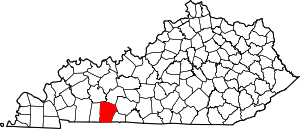
Logan was formed in 1792 from Lincoln county. The county seat of Logan is Russellville.
Lines in Logan: Hardcastle 1855-1891
The Hardcastle residence was near Gasper, in Bucksville. Their post office was
Richliew in 1860. Catherine Smith (Holsonback) was in Fillmore of Logan County
in 1870 after John QA Smith died. Their post office was Rabbitsville.
Caldwell County
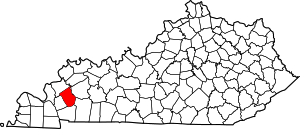
Caldwell was formed in 1809 from Logan. The county seat is Princeton.
Lines in Caldwell: Newcomb 1809-1832, Markham
It appears that Thomas Newcomb junior's mother died giving birth to him, and
his father remarried the same year. A Thomas Newcomb was in Livingston County
1820 and 1830, who was probably Thomas senior.
Calloway County

Calloway was formed in 1822 from Hickman. The county seat is Murray.
Lines in Calloway: Youngblood 1817-1860
The Youngblood residence was at Hamlin. Cadda had a first marriage which
occurred in Tennessee, then he returned to Kentucky in Marshall county. It
appears that she died either before having children or in her first pregnancy.
Cadda then moved on to start over in Mississippi.
North Carolina
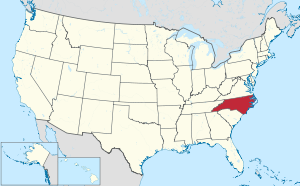
North Carolina became the 12th state in 1789. The first attempted English
settlement of what would become North Carolina was in 1584, the colony of
Roanoke, which failed. Permanent English settlement of the area began in
1650, and the Carolina province was established in 1663. The North Carolina
colony was split from South Carolina in 1712. Not mentioned below are North
Carolina counties where we have considerable history: Mecklenburg, Cabarrus,
Duplin, Bertie, Perquimans, Pasquotank. Mecklenburg and Cabarrus had a
significant German population that were our ancestors. We have many lines
that go deep into the early history of the state, along the coast. The
Newcombs lived in Rockingham county. Our White line lived in Perquimans and
Pasquotank. The Needhams were in Pasquotank. The Lancesters and Warrens
were in Warren county. The Hunters were in Duplin. The Smiths were in
Brunswick county and came from Perquimans. The Harrises were in Union county
and Cabarrus. The Wolfes were in Mecklenburg. The Todds and Trimms were in
Bertie.
Edgecombe County
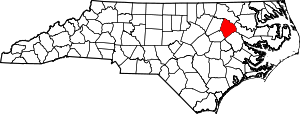
Edgecombe was formed in 1741 from Bertie. The county seat is Tarboro.
Lines in Edgecombe: Carlile 1770-1800, Parrish 1740-1746, Rigby
Johnston County

Johnston was formed in 1746 from Craven. The county seat is Smithfield.
Lines in Johnston: Hardcastle 1763-1800
The Hardcastles lived on both sides of the
middle fork of the Sandy Run of Broad River, which ended up in Morgan county.
Elisha was arrested 1790 in Lincoln county for trespass and had to pay 135 pounds.
Person County

Person was formed in 1746 from Edgecombe. The county seat is Roxboro.
Lines in Person: Parrish 1793-1832, Trimm
Granville County

Granville was formed in 1746 from Edgecombe. The county seat is Oxford.
Lines in Granville: Parrish 1746-1793, Green
Anson County

Anson was formed in 1750 from Bladen. The county seat is Wadesboro.
Lines in Anson: Griffin 1780-1820, Burrell 1770-1790, Medders 1770-1800
There may be some confusion over the residence of the Medders in Anson, as I've
seen them associated with Fayetteville which is in Cumberland county and was by
1754.
Rowan County

Rowan was formed in 1753 from Anson. The county seat is Salisbury.
Lines in Rowan: Morris 1765-1810, Sizemore 1753-1775, Whisenhunt 1760-1790, Benson 1785-1815, Ross
Wake County

Wake was formed in 1770 from Johnston. The county seat is Raliegh.
Lines in Wake: Parrish 1832-1841, Powell, Todd
The Parrish residence was at House Creek.
Surry County
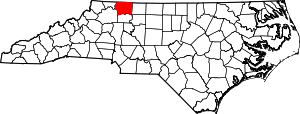
Surry was formed in 1771 from Rowan. The county seat is Dobson.
Lines in Surry: Carter 1777-1783
Burke County
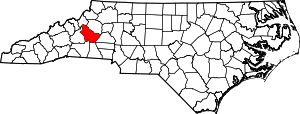
Burke was formed in 1777 from Rowan. The county seat is Morganton.
Lines in Burke: Hartsell 1775-1795, Anthony
One mystery to solve in the Scott tree is the wedding of Andrew Scott and Caty
Hartsell. Caty came to Tennessee from Burke. What's curious is the marriage
document for her has her wed to John Scott in North Carolina. I'm certain this
record applies to them, and my theory is they traveled to Burke and a Lutheran
church. That said, Caty became a Baptist in Lincoln county Tennessee. Also
note that Andrew and Caty's son William in our line claimed once that he was
born in North Carolina. My assumption is that they lived in Washington county
Tennessee in 1805, but maybe they actually were in North Carolina at first.
Burke would be the place to go to find out if that's true.
Rutherford County

Rutherford was formed in 1779 from Tryon. The county seat is Rutherfordton.
Lines in Rutherford: Hardcastle 1800-1820, Smith
John Hardcastle was in a muster roll in Rutherford 1814 for the War of 1812.
Randolph County
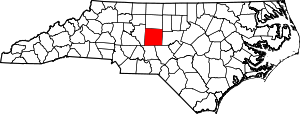
Randolph was formed in 1779 from Guilford. The county seat is Asheboro.
Lines in Randolph: Whisenhunt 1790-1825
Virginia

Virginia became the 10th state in 1788. The first English settlers landed in
1607 and founded Jamestown. 6,000 people had traveled to Jamestown and the
surrounding area by 1624, and 3,400 survived. Several of them were our
ancestors. The majority of our family lines spent significant time in Virginia,
when there really wasn't a "west" to migrate to. In such early times records
are more challenging to work through, especially as county boundaries changed
over time. Every line in Virginia is worth doing work on to untangle mysteries
that we know about, and likely many that we haven't been made aware of. Not
assigned to a section below were the Carters in what's now West Virginia but
was Monongalia county Virginia at the time. They were on Indian Creek at the
mouth of Lemasters Run near Arnettsville. The Browns who are common ancestors
of both my parents were in Stillwater of what's now Montgomery County. They
were also in Lexington of Rockbridge county. The Graysons came from Grayson
county. The Lancasters and Greens were in Surry county. The Hunters were in
Nansemond county. The Knightons and Jetts were in King George county. The
Caseys were in Botetourt.
James City County
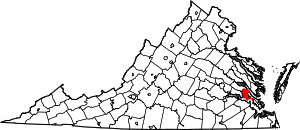
James City Shire was formalized in 1634. It was renamed a county in 1642, but
there was no effect on how it was governed. The county seat is Williamsburg.
Lines in James City: Pace 1608-1635, several others
I don't think we descend from any of those on the original voyage to found
Jamestown, but Richard Pace arrived the next year. He was famous for having
warned Jamestown about the impending Indian Massacre in 1622. Richard didn't
permanently escape such dangers as he was later killed by natives himself. His
plantation Pace's Paines was on the south side of the James River in what is now
Surry county.
Charles River County
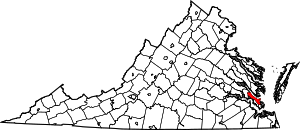
Charles River Shire was formalized in 1634. It was renamed to York county in
1643. I've treated it separately here for its historical significance, and for
clarity. York has a separate entry below. The county seat is Yorktown and was
for Charles River as well.
Lines in Charles River: Medders 1635-1643, Hardcastle 1624-1643
I have info that John Hardcastle first lived northwest of Williamsburg, but
this conflicts with other claims that he went to Old Rappahannock first. This
could be due to an assumption that the Hardcastles were always in New Kent
county, and that was formed from York. A visit to Yorktown and Williamsburg
has general vacation appeal, so at the same time maybe some genealogical work
on the Hardcastles and Medders (Meadors) could be done. The Medders residence
was actually up in the western Northern Neck, which was part of Charles River
shire/county originally.
Charles City County
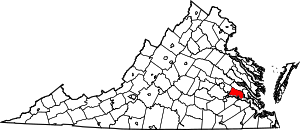
Charles City Shire was formalized in 1634. It was renamed a county in 1642.
The county seat is Charles City.
Lines in Charles City: Carlile 1657-1770, Parrish 1660-1710, Pace 1635-1800, Green
Henrico County
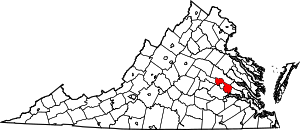
Henrico Shire was formalized in 1634. It was renamed a county in 1642. The county
seat is Laurel. Henrico was an enormous county originally, from which ten other
counties were split off over time, and three independent cities including Richmond.
Richmond hosts the county historical society.
Lines in Henrico: Griffin 1700-1750, Sizemore 1695-1720, Markham, Nance
Isle of Wight County

Isle of Wight Shire was initially formalized as Warrosquyoake shire in 1634. It
was renamed Isle of Wight in 1637 and later as a county. The county seat is Isle
of Wight.
Lines in Isle of Wight: Howell 1670-1720, Box 1625-1750, White, Lancaster, West, Green, Powell
York County
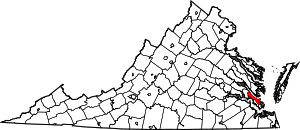
York was renamed from Charles River county in 1643. The county seat is Yorktown.
Lines in York: Medders 1643-1644, Anderson, Lancaster, Wade
I have Haskins Creek as the residence of the Medders, in what would become
Northumberland county. They were there from 1635.
Northumberland County
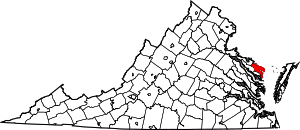
Northumberland was formed from York in 1644. The county seat is Heathsville.
Lines in Northumberland: Hollis 1647-1653, Tapp ?-1720, Medders 1644-1651
John Hallowes (Hollis) fled Maryland to Curioman Bay, which is within Nominy Bay.
Today this is part of Westmoreland county. While English settlement of the
Northern Neck began in the 1630s, our Tapp line had already been there. They
hadn't been there forever, centuries at the most, maybe less than one century,
having migrated there from points west and north. The combined Chicacoan and
Wicocomico were moved to a reservation of 4400 acres on the south bank of the
Dividing Creek between the Corrotoman River and Chesapeake Bay in 1652. The
Medders residence was Haskins Creek, in the part that became Lancaster county.
Lancaster County
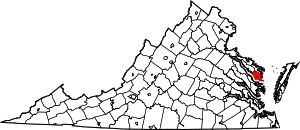
Lancaster was formed from Northumberland in 1651. The county seat is Lancaster.
Lines in Lancaster: Meredith 1680-1710, Medders 1651-1656
The Medders lived at Haskins Creek, which eventually was in Richmond county but
was in Lancaster from when it was formed until Rappahannock was formed.
Gloucester County
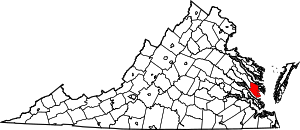
Gloucester was formed from York in 1651. The county seat is Gloucester.
Lines in Gloucester: Hardcastle 1750-1763, Hudgens
Westmoreland County
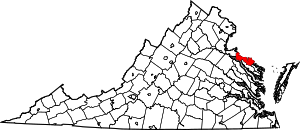
Westmoreland was formed from Northumberland in 1653. The county seat is Montross.
Lines in Westmoreland: Hollis 1653-1720
The Hollis compound in Nominy Bay became part of Westmoreland when it was formed.
New Kent County
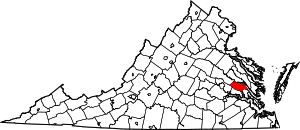
New Kent was formed from York in 1654. The county seat is New Kent.
Lines in New Kent: Meredith 1710-1740, Hardcastle 1685-1750, Parrish, Hudgens, Anderson, Markham, Hunter, Wade
I believe it was the Parrishes who lived at Slaterville. A Sampson Meredith was the
sheriff of Prince George county in 1715, so it's possible that some part of the
Meredith residence in this timeframe was in Prince George, specifically in the Bristol
township.
Old Rappahannock County
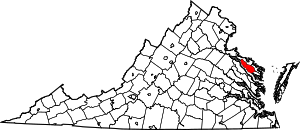
Old Rappahannock was formed from Lancaster in 1656. It became defunct in 1692 and
was divided into Essex and Richmond counties. Refer to those for research. It's
called Old Rappahannock now because an unrelated Rappahannock was created later. The
Essex county seat is Tappahannock.
Lines in Old Rappahannock: Griffin 1685-1692, Hardcastle 1643-1685, Medders 1656-1692, Jett
Stafford County
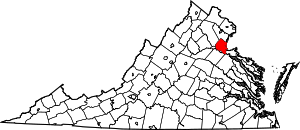
Stafford was formed from Westmoreland in 1664. The county seat is Stafford.
Lines in Stafford: Hollis 1720-1731
The Hollis residence was eventually in Fairfax, but it wasn't formed until 1742.
Richmond County

Richmond county was formed from Old Rappahannock in 1692. The county seat is Warsaw.
Lines in Richmond: Griffin 1692-1700, Tapp 1720-1755, Draper 1690-1760, Medders 1692-1725
The Griffins and Medders had been in Rappahannock. Machywap, the Taptico and origin of
our Tapp line, was banished by the Wicocomico in 1659 and the line was fairly English
in manner by 1720 when it moved to Richmond county. The Draper residence was Farnham.
Hanover County
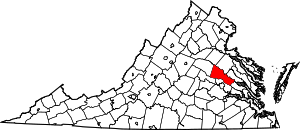
Hanover was formed from New Kent in 1719. The county seat is Hanover.
Lines in Hanover: Medders 1725-1770, Anderson, Wade
Brunswick County

Brunswick was formed from Prince George county in 1720. The county seat is Lawrenceville.
Lines in Brunswick: Sizemore 1720-1753, Burgess 1735-1746, Green
The Burgess residence was in the part that would become Bedford county.
Goochland County

Goochland was formed from Henrico in 1726. The county seat is Goochland.
Lines in Goochland: Meredith 1740-1770, Parrish 1710-1740, Hudgens
Prince William County
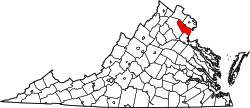
Prince William was formed from Stafford in 1731. The county seat is Manassas.
Lines in Prince William: Hollis 1731-1742
The Hollis residence was eventually in Fairfax, but was Prince William in this timeframe.
Augusta County
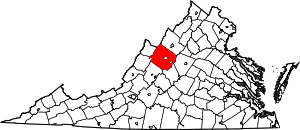
Augusta was formed from Orange in 1738. The county seat is Staunton.
Lines in Augusta: Ellis 1748-1803
If desired, answers about the origin of our Ellis line might be found in
Augusta. John Neely is believed to have fathered John Ellis.
Fairfax County
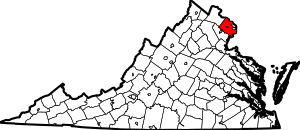
Fairfax was formed from Prince William county in 1742. The county seat is Fairfax.
Lines in Fairfax: Hollis 1742-1780, Cadwallader, Hagan
Note that Mount Vernon is in Fairfax county. George Washington was born in 1732 and
visited Fairfax as a young man and became a surveyor there when he was 17. After 1751
he moved there. Therefore, it's possible that our ancestors who lived there were
acquainted with him. They wouldn't have been his peers, as he owned dozens of slaves
at the least and was one of the wealthiest men in Virginia.
Frederick County
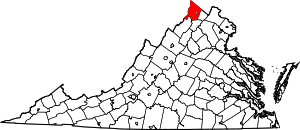
Frederick was formed from Orange in 1743. The county seat is Winchester.
Lines in Frederick: Howell 1720-1780
Lunenburg County

Lunenburg was formed from Brunswick in 1746. The county seat is Lunenburg.
Lines in Lunenburg: Burgess 1746-1753
The Burgess residence was in the part that would become Bedford county. Jason
Meadors wed in Lunenburg but didn't stay there.
Culpeper County
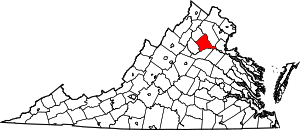
Culpeper was formed from Orange in 1749. The county seat is Culpeper.
Lines in Culpeper: Tapp 1755-1795, Bache, Jett, Trimm
Halifax County
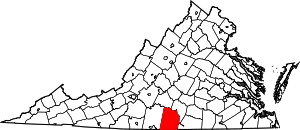
Halifax was formed from Lunenburg in 1752. The county seat is Halifax.
Lines in Halifax: Griffin 1750-1780, Wade
Bedford County
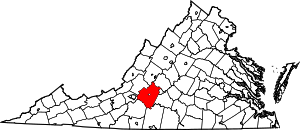
Bedford was formed from Lunenburg in 1753. The county seat is Bedford.
Lines in Bedford: Meredith 1770-1800, Burgess 1753-1783, Nance, Markham, Cadwallader
The Burgess residence in Bedford was Molly's Creek.
Washington County

Washington was formed from Fincastle in 1776. The county seat is Abingdon.
Lines in Washington: Scott 1772-1795
The Scott residence in Washington was Ebbing Spring. Technically they arrived
when it was part of Fincastle. The Daniel Boone Wilderness Trail Museum in
Duffield in Scott County is worth visiting for perspective of the Scott line's
time in Virginia and Tennessee, and any ancestors who came through northeast
Tennessee. The naming of the county is not believed to be connected to our line.
Abingdon is absolutely a key place to visit, especially to confirm all that's
known about John Scott and his operation of a trading post at the Long Island
of the Holston around 1760. There's also the story that he died there in 1803
and was cremated.
Henry County
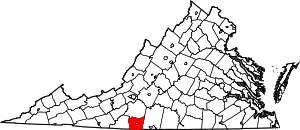
Henry was formed from Pittsylvania in 1777. The county seats are Martinsville
and Collinsville.
Lines in Henry: Meredith 1800-1826
South Carolina
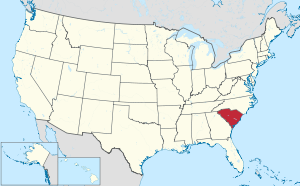
South Carolina became the 8th state in 1788. The Carolina province was established
in 1663, and the South Carolina colony was split from North Carolina in 1712. As
South Carolina had a confusing combination of districts and counties, see the map
below for the state in 1785, when counties were first defined. Prior to 1785,
residents of South Carolina were in the districts. My rule is to go by counties
once they were formed, even if they were within overarching districts. Our Casey
line lived in Newberry.
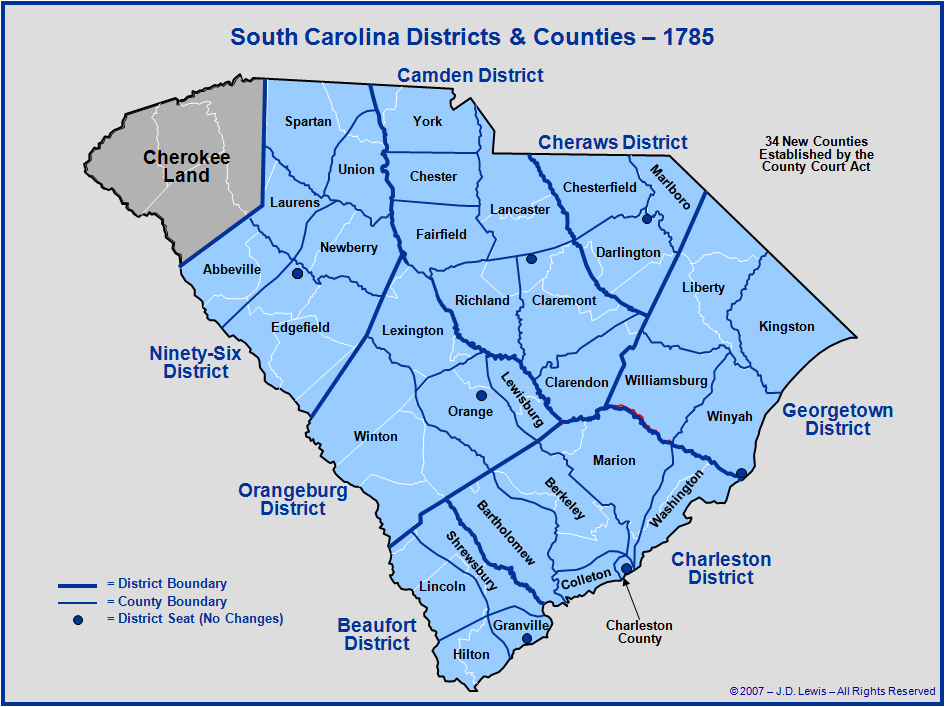
Ninety-Six District
The Ninety-Six District was formed in 1769 from Cherokee lands.
Lines in Ninety-Six: Howell 1780-1785, Draper 1760-1785, Box 1750-1785, Lee
The Howells, Drapers, and Boxes were in the part of Ninety-Six that became
Laurens county. The town of Ninety-Six would be interesting to visit.
Camden District
The Camden District was formed in 1769 from Cherokee lands.
Lines in Camden: Hollis 1780-1785, Wada Missouri, Knighton
The Hollises were in the part of Camden that became Fairfield county. The Catawba
tribe still has its headquarters in Rock Hill, which is in York county. Our
ancestor Wada Missouri was born 1758 in the town of Newton, which I'm not sure exists
anymore. As her name indicates, she was of the Missouria tribe which was merged
into the Catawba. A visit to Rock Hill would be interesting, whether or not any
new information is found. But I would like to know more about the attempted merging
of the Catawba with the Choctaw and any connections to the Boxes, Joneses, or
Drapers. I've seen a claimed connection between Wada and Orangeburg, but I don't
know what that was based on, and I don't know anything about her parents. The
Battle of Kings Mountain occurred in what would become York county, and the historic
site there would be worth visiting. John Wilson Scott, brother of our Andrew,
fought in it as a teenager and I believe that Joseph Greer and his father were
acquaintances of John Scott and Andrew's wife Caty.
Pendleton District
are
The Pendleton District was formed in 1790 from Cherokee lands in the northwestern
corner of the state.
Lines in Pendleton: Leonard 1790-1810, Griffin 1820-1826, Callahan
I have the Leonards in Pendleton beginning 1765, which wasn't possible. This is
a mystery to solve, either that they were in Maryland until 1790 or they were in
the Ninety-Six district before Pendleton was formed.
Union County

Union was formed in 1785 as part of the Ninety-Six district. The county
seat is Union.
Lines in Union: Burrell 1850-1860, Nance, Lee, Lancaster
The exact residence path of the Burrells in South Carolina isn't clear. What I
do know about Union is Paschal was in his grandfather's household at Mitchell
Creek as a laborer in 1850. I believe that his father had already died.
Laurens County
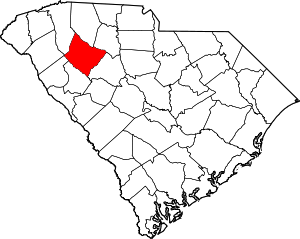
Laurens was formed in 1785 as part of the Ninety-Six district. The countyare
seat is Laurens.
Lines in Laurens: Howell 1785-1820, Draper 1785-1805, Box 1785-1805, Burgess 1785-1830, Hudgens
Our Draper connection to Wada Missouri was formed in Laurens, when Coleman Draper
wed Aninias Jones. Joel Burgess lived on Beaverdam Creek near the Saluda River.
The Hudgens residence was at the head of North Creek.
Fairfield County
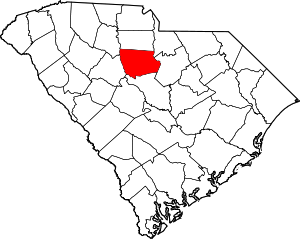
Fairfield was formed in 1785 as part of the Ninety-Six district. The county
seat is Winnsboro.
Lines in Fairfield: Hollis 1785-1830, Knighton
The Hollis residence was at Wateree Creek.
Spartanburg County

Spartanburg was formed in 1785 as part of the Ninety-Six district. The county
seat is Spartanburg.
Lines in Spartanburg: Burrell 1790-1850, Tapp 1795-1825
The Burrell residence was Dutchman Creek. I found a Sarah Burrell in the 1830
census whom I guess was Paschal's mother, further indicating that his father
had died relatively young. My expectation is Paschal was born in Spartanburg,
but as I said above, a visit to Spartanburg could help to be certain.
Edgefield County
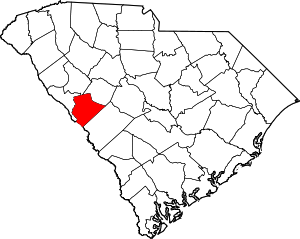
Edgefield was formed in 1785 as part of the Ninety-Six district. The county
seat is Edgefield.
Lines in Edgefield: Youngblood 1767-1817, Holsonback
No documentary evidence has been found to prove when the Youngbloods came to
Edgefield, but relatives arrived at least by 1767. Amos was in the 1810 census
there, and a John from the 1790 census is believed to have been Amos's father.
A visit to Edgefield could be informative. The Holsonbacks are also in need of
research, to connect Lewis to Matthew to Abraham. I've confirmed the connection
with ThruLines through their mothers.
Anderson County
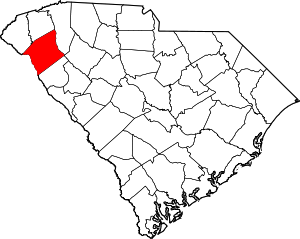
Anderson was formed in 1826 from the Pendleton district. The county
seat is Anderson.
Lines in Anderson: Griffin 1826-1865
One mystery to solve in the Griffin line is John's birth. He claimed it was in
South Carolina 1827. The Griffins are connected to Abbeville as well.
Maryland

Maryland became the 7th state in 1788. A charter was granted in 1632 and the
first settlers arrived in 1634. The Lords Baltimore, descendants of George
Calvert, were Catholic and founded Maryland as a haven for Catholics in North
America. Even so, Catholics made up no more than 10% of the population of
the province. The Hagans were in Queen Anne's county.
St Mary's County
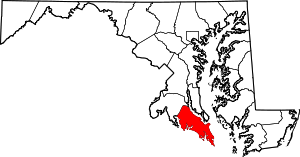
St Mary's was formed in 1634 at the landing of the first voyage of the Arc and Dove.
The county seat is Leonardtown.
Lines in St Mary's: McAtee 1674-1679, Hollis 1635-1647
John Hallowes (Hollis) landed 1635 in St Mary's, I believe on the second trip
of the Arc and Dove. Though Catholics would become a minority, St Mary's was
from the start predominantly Catholic. Even so, John Hollis was Anglican. He
seems to have gotten along fine with the Calverts, until the onset of the
English Civil War. John participated in Ingle's Rebellion and after defeat
was asked to swear fealty to Lord Baltimore. He refused and relocated to the
Virginia side of the Potomac. A Hollis Lake north of St Mary's on the
Chesapeake was named by him. Patrick McAtee landed at St Mary's three decades
later on a ship called the Batchelor and was indentured to Charles Calvert,
future third Lord Baltimore and governor of Maryland. St Mary's was the first
capital of Maryland and Patrick very well may have helped build the first
state house. But it declined over time and the capital was moved to Annapolis.
St Mary's today is a reconstruction of the original settlement.
Anne Arundel County
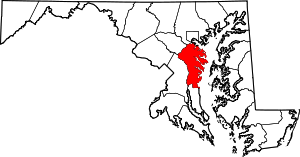
Anne Arundel was formed in 1650 from St Mary's. The county seat is Annapolis.
Lines in Anne Arundel: Burgess 1650-1735
Our Burgess line was fundamental to the founding of Anne Arundel, living initially
at South River. William Burgess was a deputy governor and there's a plaque to
him in Birdsville.
Charles County
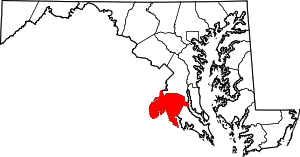
Charles was formed in 1658 from St Mary's. The county seat is La Plata.
Lines in Charles: McAtee 1679-1810, Hagan
The exact time of Patrick McAtee's move from St Mary's to Charles is uncertain,
but definitely happened by 1684. The exact history of the plantation he inherited
from his father-in-law is uncertain as well. It was at Pomfret, which is an
upscale neighborhood today. Back then it was a tobacco plantation. I visited
La Plata in 2019 but was unable to learn anything. I wasn't even able to locate
where records are stored, as I had little time. It could be worthwhile to
verify Mary Donnelly's research and find more clarity. Port Tobacco was the main
town in the McAtee's time. It would be useful to sort out all of the McAtee tree
in Maryland, because there's a lot of uncertainty. It would be good to confirm
that Edmund McAtee was Patrick's brother, and how others on the Batchelor with
similar names might've been related. Thomas McAtee II of our line was in
Montgomery county in 1810, evidently on the way to Ohio. A visit to the county
seat of Rockville could reveal more about this if desired.
Worcester County

Worcester was formed in 1742 from Somerset. The county seat is Snow Hill.
Lines in Worcester: Benson 1750-1774
Frederick County
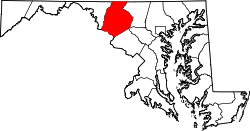
Frederick was formed in 1748 from Baltimore county. The county seat is Frederick.
Lines in Frederick: Leonard 1747-1765, Callahan, Lee, West
Samuel Leonard was born in Sharpsburg.
Massachusetts

Massachusetts became the 6th state in 1788. Plymouth was established in 1620,
and Massachusetts was an English colony until the American Revolution. Mary Chilton
was our ancestor and was on the Mayflower, connecting to us via the Winslows.
Essex County
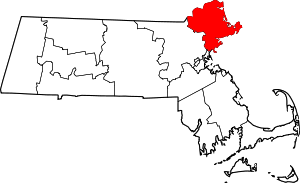
Essex was formed in 1643 as one of the first four shires of Massachusetts. The
county seats are Salem and Lawrence.
Lines in Essex: Morris 1625-1662, Breed
Our Morris line was part of the establishment of Newbury. We have other
connections to Massachusetts, including at least one Mayflower passenger. Breed
is a fascinating line from the Burrell tree, which moved from New London Connecticut
to South Carolina. They went to Connecticut from Essex. The Ormsbys were in
Bristol. The Penningtons went from Connecticut to New Jersey.
Georgia

Georgia became the 4th state in 1788, though it ratified its constitution in 1777.
The colony of Georgia had been founded in 1733. Not noted below is the Greens, who
were in Morgan county.
Franklin County
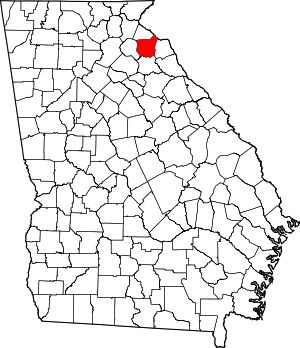
Franklin was formed in 1784. The county seat is Carnesville.
Lines in Franklin: Tapp 1825-1848, Pace 1800-1848, Meredith, Burrell, Tapp, Holsonback, McBurnett, Wade, Casey
I haven't dug into this, but a John Meredith was in Franklin 1819, as was Hezekiah
Burrell. This was probably a key point of acquaintance in these lines. Willis
Tapp was in Captain Baker's district in 1823, and John W was in Captain Adrian's
district the same year. Willis still lived there in 1840, in district 812. Lewis
Holsonback was in Frankin 1830 to 1840. Daniel McBurnett is claimed to have gotten
a land grant in Franklin 1784. Daniel took part in the Battle of Kettle Creek in
Wilkes 1779, which presumably was the origin of the grant. I've seen claim that he
also had land in Wilkes on the dry fork of Soap creek. Daniel was killed in
southeastern Georgia while leading a wagon train to Florida.
Elbert County
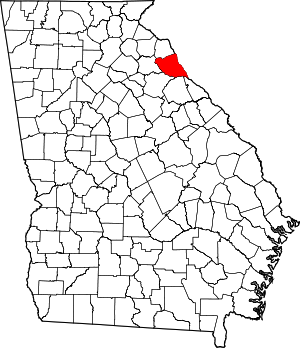
Elbert was formed in 1790 from Wilkes. The county seat is Elberton.
Lines in Elbert: Howell 1820-1855
The Howell residence in 1820 was the town of Christian. They were still in Elbert
1830, but what became of Sam and Sally is unknown. Elbert is the best place to
start to try to figure it out. KD was in the Panola Mississippi census of 1860,
and his brother and sisters went there before him. That would be a secondary
place to see if any of them ever recorded anything about their parents. My guess
would be that Sam died in the 1830s and his wife remarried. That could explain
why I've not found Sally in the 1840 or 1850 censuses, not knowing the surname of
the man she married. But it doesn't explain why I've not found KD, unless he took
on the surname of his stepfather. My guess is whatever happened, the line was in
Alabama during that time, as that's where other Howells went. A David Howell was
in the household of a Henry Howell in Randolph County Georgia in 1850 who could've been KD.
Columbia County

Columbia was formed in 1790 from Richmond. The county seats are Appling and Evans.
Lines in Columbia: Youngblood 1767-1810, Holsonback
The Youngbloods are documented having been in the Augusta area from before 1771, when
Amos's father was one of multiple related men who acquired land. The line came to
the Savannah area probably in the 1740s, initially joining the Ebenezer community.
Matthew Holsonback was in Richmond 1816. Lewis Holsonback might've also been there. He
served I believe in the War of 1812, possibly in Michigan. The Paces and Caseys were
significant in the Tapp tree, and Casey cemetery is in nearby Banks county.
Clarke County
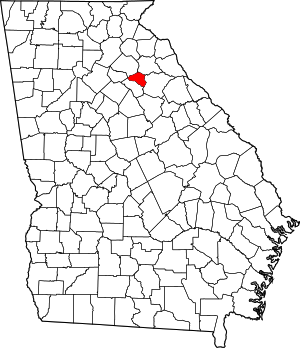
Clarke was formed in 1801 from Jackson. The county seat is Athens, home of the
University of Georgia.
Lines in Clarke: Medders 1800-1840, Martindale
The Medders residence in 1820 was Salem. A mystery to solve for the Martindales
is that Nancy's father John truly was 61 when she was born.
Jasper County
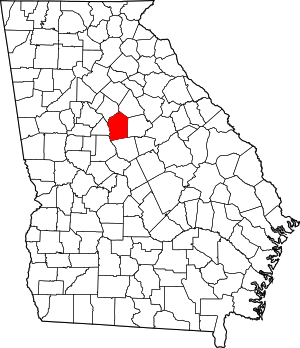
Jasper was formed in 1807 from Baldwin. The county seat is Monticello.
Lines in Jasper: Carlile 1800-1860
Jasper is a prime road trip destination to answer questions in the Carlile line.
George W Sr's birth is placed 1812 in Jasper. That's not certain. What is certain
is that George's relative John West adopted him and his sister Rachel when they were
orphaned. The exact years aren't clear. I've seen both 1812 and 1818 claimed as
the year the adoption occurred. I've seen claim that George's father John Carlile
died first and then his mother died in Alabama, and she asked that the children be
sent to John West in Jasper. Another source says John Carlile died 1811 in Jackson
county Georgia. George's mother was Mary West, and I believe that John West was her
uncle. This all occurred around the time of the War of 1812, so I wonder if a
conflict in it was the cause of this tragedy. George lived in district 373 in 1840.
James McBurnett was killed in action 1813 in Jasper.
Newton County

Newton was formed in 1821. The county seat is Covington.
Lines in Newton: Burgess 1830-1850
The Burgesses were also in Heard county.
Carroll County

Carroll was formed in 1826 from Creek territory. The county areseat is Carrollton.
Lines in Carroll: Meredith 1826-1850, Whisenhunt 1825-1850, McBurnett
Adam Whisenhunt served in the 74th regiment of the Georgia Militia against the
Creeks in 1836. The McBurnetts were in district 649 in 1840, division 11 in 1850,
and district 9 post office Bowdon in 1860.
Coweta County

Coweta was formed in 1826 from Creek territory. The county seat is Newnan.
Lines in Coweta: Medders 1840-1871
Reuben's address in 1840 was district 646. I believe they were also in Raymond and
on the Oconee river where Rose Creek joins it.
Campbell County
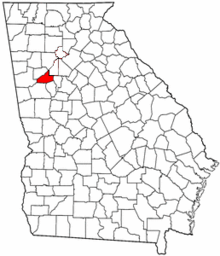
Campbell was formed in 1828 from DeKalb. The county seat is Fairburn, but used to
be Campbellton.
Lines in Campbell: Hollis 1830-1871
I've heard from a Hollis relative that they lived in a place called Dark Corner.
Elias lived in Goodes in 1870. Their post office in 1860 was Campbellton. Their
address in 1850 was district 10 and district 652 in 1840.
Walker County

Walker was formed in 1833 from Cherokee territory. The county seat is LaFayette.
Lines in Walker: Tapp 1854-1875
The Tapp residence was in Frick's Gap. I think they were close to the border
between Chattooga and Walker, and places might get confused between the two. I
have their 1860 residence in Duck Creek and 1870 in subdivision 128.
Chattooga County
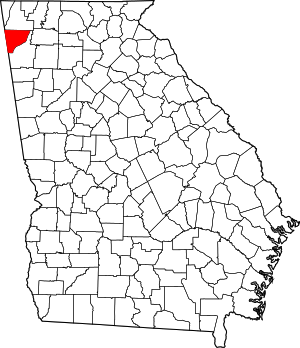
Chattooga was formed in 1838 from Cherokee territory. The county seat is Summerville.
Lines in Chattooga: Tapp 1848-1854
The Tapp residence in Chattooga census records was Broom Town Valley.
New Jersey
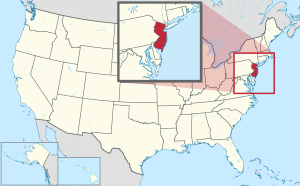
New Jersey became the 2nd state in 1787. The Dutch were the first to lay claim
to what would become New Jersey, first settling it in 1630. The Swedish purchased
territory in 1638 and began settlement of New Sweden. When the English took
control of Dutch territory in 1664, they claimed Dutch and Swedish possessions
and founded New Jersey. Our "mother line" passed through New Jersey: the Springers
and Pritchetts and Robinsons were in Burlington. The Coziers were in Monmouth.
Hugh Creighton immigrated to New Jersey, but I don't know where. It was probably
close to Pennsylvania, as his descendants went that way.
Middlesex County

Middlesex was formed in 1683. The county seat is New Brunswick.
Lines in Middlesex: Morris 1662-1765, Ross
The Morrises had been involved in the establishment of Newbury in Massachusetts.
They followed Rev Woodbridge to the Woodbridge township in Middlesex, and were
probably part of the establishment of it as well. As can be seen above, they
were in Woodbridge for over a century. Betsy Ross was born a Griscom in New Jersey
and her husband John Ross was probably related to our line.
Gloucester County
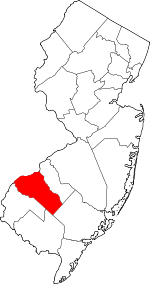
Gloucester was formed in 1683. The county seat is Woodbury.
Lines in Gloucester: Carter 1735-1777
The Carter residence in Gloucester was Woolwich.
Pennsylvania
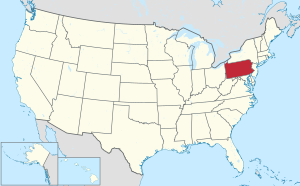
Pennsylvania became the 2nd state in 1787. Like New Jersey and Delaware, the
Dutch were the first to settle what would become Pennsylvania, and the Swedish
made a significant mark before England took ownership and William Penn came over.
The Anthonys immigrated to Berks county. The Cadwalladers were in Chester county.
The Harrises were in Lancaster county.
Philadelphia County
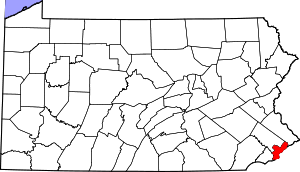
Philadelphia county was formed in 1682. The county seat is Philadelphia.
Lines in Philadelphia: Burrell 1740-1770, Martindale
Bucks County

Bucks was formed in 1682. The county seat is Doylestown.
Lines in Bucks: Hartsell 1742-1775, Martindale
The Hartsell residence was Bedminster. The Martindale patriarch was a
cordwainer (shoemaker). The Helsenbecks (Holsonback) might've lived in
Bucks for a time. Diterich (Derrick) landed in Philly 1738. Abraham was
born in 1741. The German society of Pennsylvania is in Philly.
Lancaster County
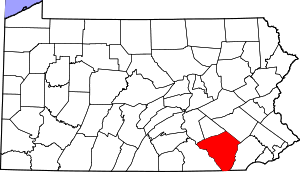
Lancaster was formed in 1729 from Chester. The county seat is Lancaster.
Lines in Lancaster: Scott 1730-1749, Whisenhunt 1731-1760
The Whisenhunt residence was Muddy Creek. I believe the Scotts were in the
Barrens which eventually were in York county.
York County
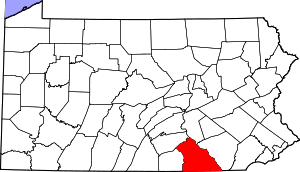
York was formed in 1749 from Lancaster. The county seat is York.
Lines in York: Scott 1749-1772
York is one of the places I want to visit most for genealogical work. I
was in Pennsylvania in 2019 partly for this purpose, but at that time I was
working under the assumption that the Scotts had been in what's always been
Chester county, at least since 1680. I had no luck, which I believe is due
to the Scotts having been in what's now York county. I believe they lived
in what's called the Barrens, on the west bank of the Susquehanna river,
probably at Peach Bottom, which has been moved away now from its original
location. I doubt that any land record can be found, because I believe they
were squatters until John Scott took the line to Virginia. It's known that
John Wilson Scott was born in York county, and I believe in the same place
they had been since the immigrant Andrew arrived about 1730. If he came in
1725 as John Wilson claimed, the Barrens were in Chester county. But any
records would be in York county today. If any leads can be found, they
still could lead to Lancaster and Chester counties. The county seat of
Chester is West Chester. Findagrave.com has John Scott born in Philly,
which I doubt, but could be worth a visit if nothing else is found.
Delaware
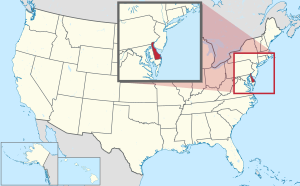
Delaware became the 1st state in 1787. Like New Jersey, it was part of
New Sweden before the English took possession. Ann Pritchett of our
"mother line" was born in Wilmington.
Sussex County
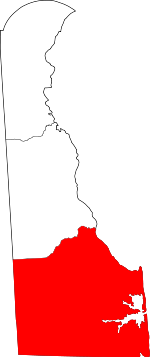
Sussex was formed in 1680. The county seat is Georgetown.
Lines in Sussex: Benson 1774-1785
Ireland

The cultural formation of Ireland began about 600BC with the coming of
Celtic-speaking peoples who had the technologies of ironworking and
agriculture. The hunter-gatherers who had resided there from as much as
12,000 years ago were greatly outnumbered by the Celts and were subsumed
into the beginnings of Gaelic culture. The nature of Celtic tribes was
to divide into warring kingdoms and hill-forts. This was the state of
affairs throughout Ireland and Britain when the Romans conquered the
tribes in what would become England about 2,000 years ago. The Romans
had some interactions in Ireland, but the Vikings had a much bigger
impact, establishing some of the largest towns over time and becoming
enthusiastically Irish. As far as I can tell, there was no unified
state called Ireland until 1542, and that was imposed by England before
they began plantations there. That resulted in the separation of
Northern Ireland, leaving the rest unified by Catholicism and resistance
against the United Kingdom. Robert Lennard (Leonard) immigrated to
Maryland from Ireland, but I don't from which part. The same applies
to John Sr and Jr Callahan. Hugh Creighton came from County Down.
Joseph Newcomb was known as "Irish Joe" but I don't know where he came
from, or if he immigrated as a child, or what his father's name was.
Newcomb is an English name, so evidently they were on an English
plantation in Ireland. Hickey is from County Clare. Chesney came from
Antrim. Doyle came from Leinster. Hadley came from West Meath,
ultimately from England. Kyle
came from County Tyrone, ultimately from Scotland. Hagan and Casey came
from Tyrone. One Harris line came from Donegal, ultimately from Scotland.
County Armagh
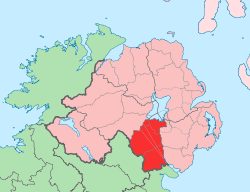
Armagh was established in 1584. It's named after the main town of
Armagh.
Lines in Armagh: McAtee ?-1652
It's probably unlikely that any family connection to the McAtees
could be found in modern Armagh. It's even possible that our line came
from neighboring County Monaghan. I believe that they were displaced
by the formation of English plantations to County Longford around 1652,
but I'm not sure. What's known is McAtee/McEntee/McGinty was a sept of
Clan Duffy in the kingdom of Airgialla. This was mostly in the area of
modern County Armagh. Armagh has general vacation value, but it would
be interesting to learn more about Airgialla and anything specific about
McAtee.
County Longford
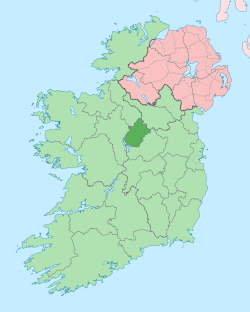
Longford was established in 1570. It's named after the main town of
Longford.
Lines in Longford: McAtee 1652-1674
I don't know for a fact that Patrick McAtee came from Longford to
America. But the Calverts were in Longford and my guess is the McAtees
got the idea to travel to Maryland by acquaintance with them. A visit
to Longford might turn up answers. Drumlish is a village in County
Longford near which was the Baltimore manor from which the name was taken
by the Calverts and brought to America.
County Galway
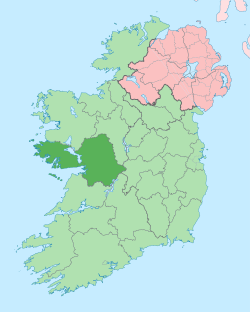
Galway was established in 1569. It's named after the main town of
Galway.
Lines in Galway: Leonard ?-1747
County Londonderry
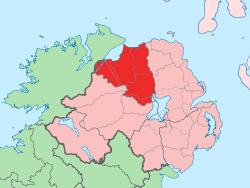
Londonderry was established in 1613 from county Colraine. The name is
a modification of Irish Derry, which was a diocese name there when the
English built the walled city they named Londonderry.
Lines in Londonderry: Scott ~1641-1725
I have no direct evidence of where in Ireland the Scotts came from, but
I do know it was in Ulster as they ultimately came from Scotland. I
only guess Londonderry based on the frequency of Scotts I found in
Londonderry when trying to find our immigrant Andrew. Our Scott line
was a military one, and it makes sense that they took part in the
defense of Londonderry. The largest movement of Scottish soldiers to
Londonderry was in 1640, so that's my default guess. I have seen
documentation of Ulster-Scot lines who were in Ulster for one generation
at the most, so that could be the case for us. From what I know,
documentation in the 18th century and earlier is lacking, so I don't
expect to ever be sure. A visit to Londonderry would be interesting in
general as a vacation, but I don't know if any productive genealogy
could be done there. The best place to go for research is the Public
Record Office of Northern Ireland (PRONI), which is in Belfast.
Scotland

Prior to the arrival of Romans at the beginning of the common era,
Scotland was populated by Celtic tribes much like those in Ireland. The
Romans succeeded in subduing the tribes in what would become England and
Wales, but they had more difficulty in future Scotland. In the lowlands
the Romans had a significant impact, but they established no foothold in
the highlands, the land of the Picts. About the time Roman power began
to withdraw from Britain, a migration from the Irish kingdom of Dal Riata
moved into the northwestern highlands. This was the trigger that
eventually led to the formation of the kingdom of Scotland in 843. The
border part lowlands were a lawless region for the most part, throughout
the time that our ancestors were there. Almost all of our Scottish
ancestors came from the lowlands, and most of them from the borders. The
Creighton surname came from Crichton. McBurnett comes from the Hebrides.
Reid came from Inverness. Ross, McClendon, and McIlhenny come from the
highlands and trace back to Dal Riata. Gillespie came from Perth. Trail
and Todd came from Angus. Todd stopped over in Ulster before going on to
North Carolina. Blair and Kyle came from Ayrshire. One Henderson came from the
highlands, and there must've been a Viking connection. Another came from
Fife. Ezell and Armstrong came from Dumfriesshire. Cursiter came from Orkney. The
Browns who were common ancestors of both my parents came from Scotland,
but I don't know exactly where. Clark came from Argyll. Barkley came
from Kincardineshire.
Roxburghshire

Roxburgh county was established in the 1100s. Its main town is Jedburgh.
Lines in Roxburgh: Scott 142-1641
I don't suppose I'll ever be able to prove that our Scotts came to Britain
with the Romans, but you can read my explanation of it in the Scott page.
I believe that our line came to the Eildon area in AD 142, and Melrose and
what preceded it were the center of their world for 1200 years. The
primary attraction there is the Trimontium museum. Buccleuch is the seat
of Clan Scott, but that's been in the hands of interlopers for a long time,
gentry that wed into the Scotts. I have little interest in it, but our
ancestors did join the Clan. The path our line took from Hadrian's Wall to
Trimontium was called the Dere Street, which ran down approximately to
Newcastle. They also went to Bar Hill fort on the Antonine Wall, which was
northeast of modern Glasgow.
Fife
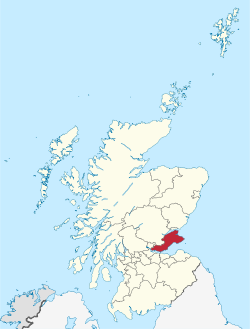
Fife county descends from a Pictish sub-kingdom. Its main town is Glenrothes.
Lines in Fife: Burrell ?-1740
Wales

Like Ireland and the rest of Britain, Wales was occupied by Celtic tribes
when the Romans arrived at the beginning of the common era. Wales was
subdued by the Romans, and it formally merged with England in 1485, but it
still retains more of a Celtic character. Our Sturdivant line came from
Wales, but I'm not sure exactly where. Our Evans line came from
Carnarvonshire. We have multiple Williams lines, but I don't know where
exactly any of them came from.
Pembrokeshire
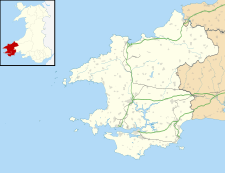
Pembrokeshire was the petty kingdom of Dyfed until the Normans invaded,
and after they built the town of Pembroke the surrounding area was named
after it.
Lines in Pembrokeshire: Howell 1070-1620, Griffin 1070-1675
Our Howells have a Viking Y-DNA, and since they came to America from
Pembroke, it appears that they came to Wales as Normans. The Griffins
have Celtic Y-DNA, so they could've been native Welsh but also came from
Pembroke. I'm assuming that both lines came with the Normans. The Griffin
surname is very odd, being known as Welsh but being most common outside
Wales, especially in Ireland. It's possible that both lines were in Wales
when the Normans arrived. It would be interesting to visit Pembroke
regardless of family history, but any historical context could inform
specifics for our ancestry.
Powys

Powys is a relatively new county that contains old Radnorshire, centered
on Old Radnor.
Lines in Powys: Meredith 1070-1680, Cadwallader, Jones
The Merediths have the same Viking Y-DNA as the Howells, but their
connection to the Normans isn't as clear. They may have come with the
Angles and Saxons. A visit to Old Radnor might be informative on such
a question.
Newport
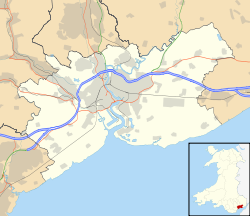
Newport is a county borough dating back to around the year 1120.
Lines in Newport: Carter 1070-1735
The Carters have the same Y-DNA as the Howells and Merediths, indicating
that they came to Wales with the Normans.
England

Our family history with the country of England is both broad and deep.
Broad, because more of our ancestors came from there than any other
country, and deep because our ties go back significantly to the Romans, and
Y-DNA tells of a history even to hunter-gatherers 10,000 years ago and
more. Celtic culture began to arrive in Britain and Ireland about
3,000 years ago and pre-Celtic cultures were in England thousands of
years before that, to the time that Stonehenge was constructed. When
the Romans conquered what would become England about 2,000 years ago,
they brought a great diversity of cultures together and we see it today
in our DNA. As Roman power receded about 400 AD, British leaders began
calling on Germanic mercenaries for help, which helped lead to the
establishment of the Angles, Saxons, Jutes, Frisians etc in the island
and the roots of what would define the English. I believe this was
more of a cultural change and establishing of a broad ruling class than
a genetic change, as the deeper Celtic DNA remains predominant to this
day. The pattern of Indo-European culture all over the globe follows
more of a cultural than genetic impact. The development of England had
already been a bumpy ride when William the Conqueror invaded in 1066
and again replaced the ruling class of Britain. England was changed
once again by a Latin influence, particularly the English language,
this time via the French. The Normans became English as other Vikings
before them had merged into other cultures, and the English language
and British culture we have now is the result. The main Smith line
(Hardcastle tree) came from Lincolnshire.
Not separately mentioned below: the Martindales, Lancasters, Daniels,
and Wests came from Bristol. The Hudgens came from Llandaff in
Monmouthshire. Pritchard came from Liverpool, ultimately from Wales.
The Markhams and Luttrells came from Nottinghamshire. Adams came from
Oxford, also Welsh. Newman came from Oxfordshire. Heard and Garner
came from Shropshire. Pate came from Northamptonshire. Crews, Brummell,
Langston, Hayes, Hunt, Mobberley, and Lee came from Cheshire. Dudley, Winslow,
Knowles, and Bache came from Worcestershire. Wilkinson came from
Gloucestershire. White came from Chester. Breed came from Bedfordshire.
One Harrison line came from Staffordshire. Rowland came from Surrey.
Pennington came from Cumberland. Williford came from Leicestershire and
traces back to a mayor of London. Pate came from Leicestershire.
Tindall and Hensley came from Devonshire. We have a Canterbury line
that presumably originates from the place of the same name. Foster and
Newby came from Durham. Trimm came from Dorset.
London

The city of London dates back to the Romans, who founded it as
Londinium about 50 AD. We have several ancestors who immigrated to
America from London, but I'm not sure how useful that is to tracing
the origins of the line as it seems that such lines became mobile in
the preceding decades, coming from places as far away as Wales or
Cornwall or Scotland.
Lines in London: Sizemore 1660-1695, Hearne, Fewell, Wade, Jett, Duckett, Badgett, Brandon
The British Museum is a must-visit.
Middlesex

Middlesex goes back to the Kingdom of Essex in the 6th century. The
name basically means the middle part of Saxony. It's now absorbed as
part of Greater London. Our Turner line and one Harris line came from
Essex. Our Beals line came from Sussex but traces back to Cheshire and
ultimately Yorkshire.
Lines in Middlesex: Pace ?-1608, Clements
Richard Pace came from Wapping.
Kent

Kent was founded by Celts and its name has a Celtic origin. It
existed before the Romans came.
Lines in Kent: Carlile ?-1670, Harrison (Carlile tree), Terry, Faulkner, Grayson
The Carlile patriarch is said to have come from Maidstone, which is
the main town of Kent. The Carliles are also associated with Barham.
Hertfordshire
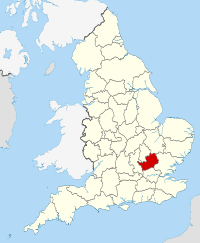
Hertfordshire dates back to Roman times and is named after its town
of Hertford.
Lines in Hertfordshire: Medders ~1600-1635, Anderson, Hartford, Merrick
The Medders (Meador/Meadow) patriarch came from Watford, moving there
decades before coming to America.
Buckinghamshire

Buckinghamshire dates back to the Celts and is named after Buckingham.
Lines in Buckinghamshire: Howell ?-1670
The Howell patriarch came from Marsh Gibbon.
Hampshire
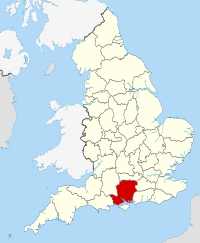
Hampshire is believed to have been a congregating place dating
back to hunter-gatherer times, and had Celtic hill forts constructed
long before the Romans arrived. It's named after the town of Southampton.
Lines in Hampshire: Box ?-1625
The Box patriarch came from Sherfield.
Wiltshire
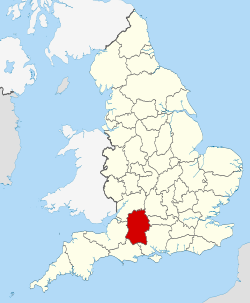
Wiltshire is the home of Stonehenge and has a similar deep history to
Hampshire. It's named after the town of Wilton.
Lines in Wiltshire: Morris ?-1625, Bailey, Knighton
The Morris patriarch came from Trowbridge and joined other founders of Newbury
in early Massachusetts. The Baileys came from Chippenham.
Somerset
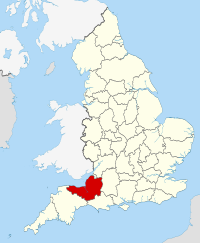
Somerset like Wiltshire and Hampshire was frequented by hunter-gatherers from
many thousand year ago. The remains of Cheddar Man were discovered in Somerset.
Lines in Somerset: Griffin ?-1650 West Pennard
Somerset is between Cornwall and Wales, which makes sense with a Welsh name
like Griffin. But how exactly Griffins don't seem to be common anymore in
Wales itself is a prime question to find an answer to.
Cornwall
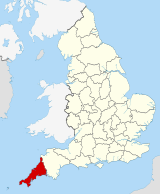
Cornwall bears a lot of similarity to Wales, being a western-flung part of Britain,
and thus geographically prone to retaining more of a Celtic character than England.
Lines in Cornwall: Burgess ?-1650, Keeter, Nance, Wheelis, Mullis, Stone, Bridgeman
The Burgess patriarch came from Truro. The Nance line was a big deal in Cornwall.
Coale is Cornish, but our line immigrated from Essex.
Suffolk
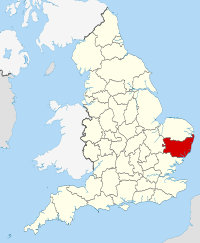
Like how Wessex and Sussex and Essex and Middlesex were divisions of Saxon peoples,
Suffolk and Norfolk were divisions of Angles.
Lines in Suffolk: Medders ?-1600, Powell
The Meadows name came from Witnesham.
Norfolk

Like how Wessex and Sussex and Essex and Middlesex were divisions of Saxon peoples,
Suffolk and Norfolk were divisions of Angles.
Lines in Norfolk: Benson ?-1750, Thacker, Pettus
The Benson patriarch came from Yarmouth.
Yorkshire
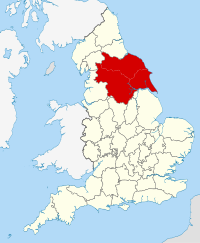
Yorkshire was a center of power of Celtic tribes when the Romans came, but eventually
they were subdued. Yorkshire is named after the city of York.
Lines in Yorkshire: Hardcastle ~1250-1625, Draper ?-1690, Parrish ?-1660, Tennison, Wadsworth, Franks
The Hardcastles came to York in the 13th century, fleeing conflict with Scots probably
around Hadrian's Wall. The name Hardcastle came from their home in the north. Their
base in Yorkshire was Pateley Bridge, and probably still is. The Drapers are a fairly
well-known group, with the New England faction having a book written about them. They
came from Heptonstall. The Parrishes are curious because the Parisi Celtic tribe was
based around Yorkshire. The name Parrish is known to be related to Paris in France,
as were the Parisi. Probably ours came with the Normans, but it's curious to me to
wonder if they trace all the back to the Parisi. The Baileys may have been connected
to Yorkshire.
Lancashire
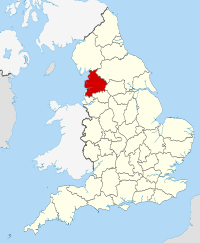
Lancashire was another stronghold of Celtic tribes when the Romans arrived. Lancashire
is named after the town of Lancaster.
Lines in Lancashire: Morris ?-1500, Hollis ?-1635, Sizemore ?-1660, Rigby, Lancaster, Booth, Kirkham, Baldwin
I have the Sizemores moving from Scarisbrick to London before coming to America, but
I'm not positive about it. The Hollis patriarch came from Rochdale. Hugh Rigby came
from Wigan.
Carlisle
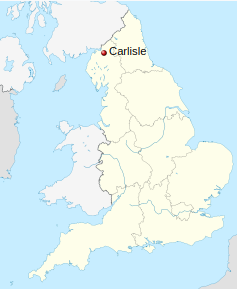
The town of Carlisle is interesting in our ancestry in two ways: one is the origin of
our Carlile line and the other is it marks the western end of Hadrian's Wall. Carlisle
had been the site of a Celtic tribe before the Romans came, and had been part of Scotland
before Norman power pushed the English border northward. The Hollis connection is
earliest, going back to the Roman town Luguvalium. The Hollis line has a very odd African
Y-DNA that I believe came to the Carlisle area with the Romans, specifically at the Aballava
fort at modern Burgh-by-Sands. I only infer a Carlile connection to Carlisle, as it had to
be the origin of the name, but I don't know when our line departed. As far as I know, the
name has generally seemed to move away, and it would be interesting to learn why.
Lines in Carlisle: Hollis, Carlile
Northumberland
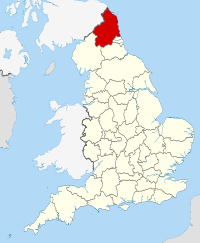
Hadrian's Wall is a significant entity in our ancestry. I believe that at least two of
our ancestral paternal lines came from Roman auxiliaries stationed at the Wall, and many
immigrated to America from the border region between England and Scotland. That region
was unstable and fought over between nations going back at least to Roman times. Newcastle
marks the eastern end of the Wall, and was the site of the Arbeia fort.
Lines in Northumberland: Scott, Lindsey, Hunter
Dere street was mentioned in the Scotland section, but it covered most territory in modern
England. It went south from Clan Scott territory through Corbridge on the Wall down to
York. I'm not sure what value can be found in attempting to trace it on modern roads and
highways, but certainly the path that Hadrian's Wall took would be rewarding to follow.
I'm very certain, even though it's probably impossible to prove, that our Scott line came
from Syrian archers who were stationed at Magna/Magnae/Magnis fort near the Wall. I don't
believe there's much to see on the site now, as the Vindolanda museum to the east seems to
contain the story and recovered artifacts. Corbridge could be the site of the tower that
the Hardcastles were named after, maybe even a Roman milecastle. Chesters would be worth
visiting.
Germany

People who speak Germanic languages, broadly Germanic people, established their culture
in an area from the north of what would become Germany farther northward through Scandinavia.
As stated in the Netherlands section, a cooling period in the centuries before the Common
Era began, drove a southward migration of these people into contact with the emerging
Roman empire coming from the south. It was Germanic tribes that would hasten the fall of
that empire, called barbarians by the Romans because Germanic language sounded uncouth to
them compared to Latin. Germanic languages would arise, including English of course, to
compete with Latin-based languages for supremacy and be spread to the New World. In 843 AD
the majority of what would become Germany was the eastern half of a Frankish empire. The
concept of Germany began to arise after that, but as Catholics they carried on the legacy of the
Romans as the Holy Roman Empire. With the Protestant revolution there was continual conflict,
which resulted in the migration of our German ancestors to America. In 1815 the German
confederation was formed, and the country of Germany that we know today was formed in 1871.
Before either of the last two events, our German ancestors were already long gone.
Lines in Germany: Youngblood ?-1739, Whisenhunt 1682-1731, Hartsell 1651-1742, Holsonback ?-1738, Antoni, Sechler, Biffle, Rouse, Wolfe, Doster, Ehret, Harmon, Young, Wagner
Both the Whisenhunts and Hartsells were German-speaking peoples, coming from Switzerland.
It seems certain that wars caused the movement of both lines into Germany, I believe moving
in as part of a gentrification process. It also seems clear that religious persecution,
them being Lutheran, is what drove them and all other German ancestors of ours to depart for
America. The Whisenhunts came from Edenkoben and the Hartsells from Reihen. Both were
in the state of Baden. The Holsonbacks didn't come to Germany from Switzerland, but their
DNA tells an interesting story. They weren't part of the Germanic migration mentioned above,
but of a different group that came from the east. Paul Antoni came from Hundsbach. Andreas
Sechler came from Lomersheim. Biffle came from Contwig. Rouse came from Siegen. Wolfe
came from Seeburg. Doster came from Koblenz. Ehret came from Mosbach. Harmon came from
Kusel. Young came from Kassel. Wagner came from Heudorf. The Springers came from Sweden
before Pennsylvania was founded. The Youngbloods were believed for a long time to have been
Dutch immigrants to New Amsterdam, but this was based on incorrect information published before
the internet age. YDNA shows that the John Miles Youngblood line wasn't closely related to
ours, which immigrated to Georgia in the 1740s. It's not been verified exactly where they
came from, but it was likely the Rhineland.
Switzerland

The land that would become Switzerland was at the crossroads of the Romans, the Franks, and
the Germans. When Roman power withdrew, Switzerland remained at the intersection of what
would become France and Germany, French on the western side and German in the northeast.
Switzerland became a country in 1848 and has a tradition of neutrality. It also has a
tradition of affluence. We have a much deeper connection to the area of Switzerland, via
the Hunters who have Y-DNA that points to northern Italy, centered on Milan. It's possible
that they were early migrants before the time of the Romans, but they could've also come to
Britain with the Romans.
Lines in Switzerland: Whisenhunt ~700-1682, Hartsell ~700-1651, Brakefield, Rothgeb, Martine
A visit to Switzerland could help to clarify the dynamics that caused our Whisenhunt and
Hartsell lines to leave. Both occurred in the 17th century. My understanding is they
were summoned to the Baden state for religious reasons. If there hadn't been religious
conflict in Switzerland, they came into it in Germany. The Whisenhunts were from Bern and
the Hartsells were from Zurich. Brakefield came from Bern. Rothgeb came from Zurich.
France
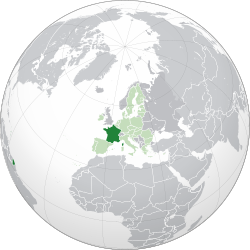
As far as I know, France comes from what was the most powerful Celtic kingdom that the
Romans faced in the expansion of their empire. It was called Gaul, related to the term
Gaelic. The area of France (and Germany) was the crucible where Celtic culture developed
in the Iron Age, and it spread into Britain and Ireland. This is one of the most significant
elements of our heritage. Another that occurred in France actually came from foreign
invaders, the Vikings. Scandinavians landed on the French peninsula that would be named
Normandy, when the Vikings were such a threat that the French gave these north-men that
territory. Then the Normans became enthusiastically French and William the Conqueror got
his name by conquering England. Norman influence is all over the names of our ancestors,
but I believe that in most cases this was a cultural thing and most of them already lived
in England (with a Celtic origin). All of this came from France, yet none of these
influences are called French. Even so, we have a few ancestors who were French. They I
believe were mostly Lutherans and came to America for the same reasons the Germans did.
Our French ancestors typically came from the region of Alsace on the German border. This
happened before the American Revolution, long before the German confederation, and what
differentiated them was really only language. Our German and French ancestors were
genetically similar and lived basically in neighboring states.
Lines in France: Antoni, Wull (Will), Pinson, Chambliss, Carmon, Grizzle, Winegar, Hardin, Duvall
Caspar Antoni moved from Durstel to Germany before continuing on to Pennsylvania. Jean
Pinson came from Avilly Saint Leonard, north of Paris. Grizzle (Grissel) came from Lorraine.
Duvall came from Normandy to Maryland.
Outside Europe
We have no definite ancestry from outside of Europe, not in the past several centuries.
But we have some unique Y-DNA that points to deeper movements. For example the Hollises,
whose Y-DNA is 99% still in Africa today and is very rare anywhere else. And the Scotts,
whose Y-DNA is from the Middle-East. It's not uncommon in southern Europe, but is quite
rare in Britain. And yet in both these cases, they are absolutely British lines. The
Hollises were very English, and the Scotts were very Scottish, or at least lowlands
Scottish, which is one step from northern English. I believe that both of these lines
got to Britain via the Romans, with the Hollis DNA from around Morocco and the Scott
from Syria. The Hollis case is less certain, but most likely came from a Berber-type
tribe. The Scott case would be similarly unclear, if not for 500 Syrian men known to have lived
in Clan Scott territory in the 100-200AD timeframe. Those men came from the town of
Hama. Unfortunately there's no prospect of a visit to Hama being safe in the coming years.
Ukraine is an even less safe place, but would be interesting to visit for deep connections
to Celtic and general Indo-European migration through there. Of course Rome itself would
be a place to visit to learn not only more about the Romans, but about its far-flung territories.
last edited 30 May 2023
